
A temporary exhibition at the Geological Society of France prepared by : Camille FRANÇOIS, Solen LE GARDIEN, Violaine SAUTTER & David C. SMITH.
With the support and assistance of Mary Inglis, A. Rosu & S. Chaimbault
Download the brochure here.
ABOUT THE EXHIBITION
In collaboration with the Muséum National d'Histoire Naturelle and the Commission de la Carte Géologique du Monde, this exhibition allows visitors to discover eclogites, rocks formed in the depths of the Earth, through works from the SGF's documentary collection and, above all, samples from the COSEM: the Commission for the Geological Map of the World. Collection Smith des Eclogites Mwave.
Why the term "eclogite" and why Norway?
Abbé René-Just Haüy coined the term "eclogite" from the Greek "ἐκλογή" (eklogê) meaning "choice". He believed that these rocks "chose" to be different from others, and described them in his Traité de minéralogie of1822.
In 1920, Pentti Eskola (1883-1964) published a classification of metamorphic rocks based on the innovative concept of "facies", including a description of what he defined as an "eclogitic facies". The following year, he published a work on the eclogites of Norway in "Le Gneiss de l'Ouest", an enormous unit of more than 200 km of nappes that have been metamorphosed.
At the same time, Yvonne Brière (1891-1981), one of the first female geologists in France, proposed a metamorphic origin for eclogites in her thesis "Les éclogites françaises: leur composition minéralogique et chimique; leur origine", defended at the Faculté des Sciences de Paris and published in 1920. This idea, which was strongly criticised by his thesis jury, is now unanimously accepted.
Since the 1960s, with the advent of new analytical methods in petrology (electron microprobe, etc.), many other researchers have taken an interest in eclogites to understand how they can outcrop on the Earth's surface after having been created at such great depths.
A paradigm shift in geodynamics: subduction of continental crust
In 1984, the discovery of the mineral coesite in rocks of the continental crust in Italy (Chopin, 1984) and in eclogites in Norway (Smith, 1984) revolutionised geodynamics. The presence of coesite in eclogites proves burial at depths two to three times greater than previously assumed (around 100 km). It also shows that the continental crust can subduct to great depths.
A new discipline was born, called UHPM (Ultra-High Pressure Metamorphism).
This exhibition begins with a definition of eclogites and metamorphism (showcases 1 to 3) and the geodynamic processes involved in the formation of these rocks (showcases 4 to 7). It continues with the highly diverse mineralogy of Norwegian eclogites (display cases 8 to 14). The study of COSEM rocks has enabled David and his colleagues to describe new species: nyböite, Mg-Al & Fe-Al-taramite, lisetite and davidsmithite, all recognised by the International Mineralogical Association (showcases 15 & 16). The exhibition concludes with the geodynamic implications of the discovery of these rocks throughout the history of our Earth (showcase 17).
This exhibition will take you on a journey from the infinitely large to the infinitely small. The study of eclogites is a vast field, ranging from regional geodynamics to crystallochemistry.
Eclogite is a grey rock composed of red garnet and green pyroxene (omphacite, Greek for green grapes). In 1822, Abbé René-Just Haüy was fascinated by this rock (sample 505 showcase) with bright colours (no feldspar), made it a rock of choice by naming it "eclogite" (from the Greek ἐκλογή meaning "choice", referring to the selection of minerals that make up this rock). For Haüy, diallage (the old name for clinopyroxene) was " considered to be a basic function and, with garnet, formed a binary combination to which kyanite, quartz, epidote and laminar amphibole were supposed to be accidentally added". Before Haüy, these rocks had been spotted 40 years earlier in Bavaria by Horace Bénédict de Saussure.
The great German geognosist Abraham Gottlob Werner was also familiar with some eclogites from the Austrian Alps and southern Germany, in particular the well-known Silberbach deposit (sample 25 Ec). He described them as consisting of garnet, "omphazit" and, occasionally, "cyanit" (Werner, 1817).
The name eclogite was used by European geologists to designate rocks from Germany, Austria, the Alps and Norway. In France, the first discovery of eclogite was made by Auguste Rivière in the Vendée region (sample P1567), where he discovered "the beautiful rock that bears the name of eclogite" (Rivière, 1835). The first study of these rocks was carried out by Alfred Lacroix in 1891, then by his student Yvonne Brière in 1920 (see window 2).
This thin blade on display is a kimberlite eclogite composed mainly of red garnet and green pyroxene (Roberts Victor mine, South Africa). A kimberlite (from the town of Kimberley in South Africa) is a very brecciated ultrabasic magmatic rock deeply rooted in the mantle and rising to the surface at Mac 2 speeds, with nodules of eclogite, peridotite and diamonds.

Books on display:
Hommage à Haüy: Société française de minéralogie (1945). - René-Just Haüy, 1743-1822, Paris, Masson, 348 p.

René-Just Haüy (1743-1822) was a French mineralogist and the founder of crystallography (with Jean-Baptiste Romé de Lisle). Destined for the priesthood, he discovered botany and then mineralogy, and in 1781 published an article on the structure of garnet crystals. Admitted to the Académie des Sciences in 1783, then to the Muséum National d'Histoire Naturelle, he described and named a large number of mineral species in his A treatise on mineralogypublished in 5 volumes (including one with plates) in 1801. It was in the second edition of this Treatypublished in 1822, that he described a rock he called "eclogite", in a chapter on diallage (clinopyroxene): "I gave this rock the name of eclogite, which means choice, election, because its components, not being of those which commonly exist several together in the primitive rocks, like feldspar, mica, amphibole, seem to have been chosen to form a separate band". (Traité de Minéralogie, 2nd edition, Vol. II, p. 456). The sample H505 on display is a Bavarian eclogite studied by Haüy.
Saussure, H.-B. de (1779-96). - Voyages dans les Alpes, précédés d'un essai sur l'histoire naturelle des environs de Genève, Neuchâtel, S. Fauche, 4 vols, Vol. I, pp. 155-156 :
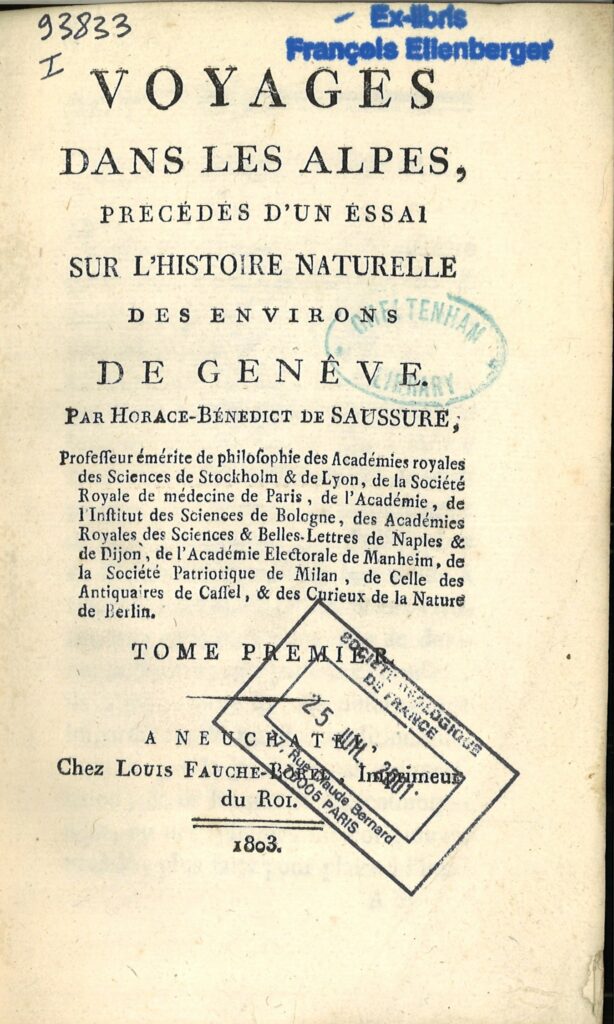

Horace-Bénédict de Saussure (1740-1799) was a Genevan scholar interested in physics, geology, mineralogy, meteorology, botany and philosophy. Fascinated by the Alps from an early age, in 1760 he offered a reward for the ascent of Mont Blanc, which was successfully completed in 1786 by Jacques Balmat and Michel Paccard. Saussure reached the summit the following year and recounted his experiences of the Alps in his Trips in the Alpspublished in 4 volumes between 1779 and 1796.
In the first volume of his Travel, Saussure describes a rock "described nowhere: it is a mixture of jade, green spathic schorl and garnet in mass. This stone, of considerable hardness and density, takes on a beautiful polish, and the large red, green and yellow spots form a very beautiful effect". (Trips in the AlpsVol. I, pp. 155-156). This would appear to be the first description of eclogite, more than forty years before Haüy described and named it.
The copy presented bears the inscription "Ex-libris Ellenberger". Before being donated to the SGF library, the book was part of the collection of François Ellenberger (1915-2000), a French geologist whose work included the structure and metamorphism of the Alps. He was also the founder of the French Committee for the History of Geology (COFRHIGEO) in 1976, and took an interest in the figure of Horace-Bénédict de Saussure in his work History of Geology.
To find out more :
- Collective (2015). - Regards croisés sur le métamorphisme, Geochronic136, pp. 7-82
Available from the SGF shop: https://www.geosoc.fr/boutique-en-ligne/geochronique/regards-crois%C3%A9s-sur-le-m%C3%A9tamorphisme-detail.html
- Ellenberger, F. (1988-1994). - Histoire de la géologie, Paris, Technique et documentation Lavoisier, 2 vols, 381-352 pp.
- Haüy, R.-J. (1822). - Traité de minéralogie, Seconde édition, Paris, Bachelier et Huzard, 4 vols + 1 atlas vol.
- Godard, G. (2001). Eclogites and their geodynamic interpretation: a history. Journal of Geodynamics32(1-2), pp.165-203. https://doi.org/10.1016/S0264-3707(01)00020-5
2. ECLOGITE, A METAMORPHIC ROCK
Work on eclogites continued in the following years, mainly on mineralogical compositions, but their magmatic or metamorphic origin remained a matter of debate. Among those in favour of a magmatic origin, Pentti Eskola (1921) considered that Norwegian eclogites had crystallised from an "eclogitic magma" under conditions of high pressure (HP). Conversely, Yvonne Brière (pictured in the display case) claimed that French eclogites resulted from the metamorphism of gabbroic rocks.

Yvonne Brière (18/08/1891-23/12/1981) was the first woman to complete a thesis in the Muséum's Mineralogy Laboratory (and one of the very first in France), under the supervision of Alfred Lacroix (1863-1948). She was awarded a doctoral scholarship from 1917 to 1919. There she took up a subject abandoned by a student who had entered religion, the study of ECLOGITES, of which she visited numerous deposits in the Vendée, Loire Atlantique (sample 9 Ec), Morbihan and Limousin.
MNHN
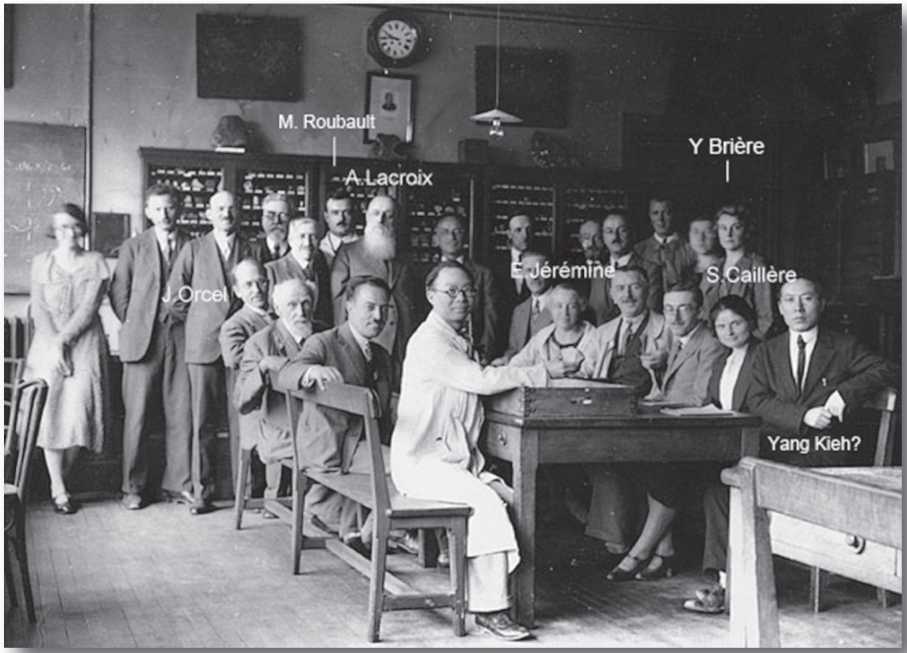
She defended her thesis at the Sorbonne in 1920. Based on global chemical analyses of a number of samples, she defended the idea that eclogites are metamorphic rocks that result from the transformation of magmatic rocks (of basaltic composition, such as gabbro CF1 presented in the showcase). This conclusion, now universally accepted, was strongly criticised by his thesis jury at the time.
She then worked as a trainee at the Laboratoire de Minéralogie between 1920 and 1923, leaving it much to her regret to emigrate to Madagascar, then a French colony. She returned to the Laboratoire de Minéralogie as a volunteer shortly before the Second World War. The copy of her thesis presented here is dedicated to Alfred Lacroix.
Extract from the doctoral thesis of Y. Brière showing the chemical composition (by weight of oxides) of the sample 9 Ec on display.
MNHN
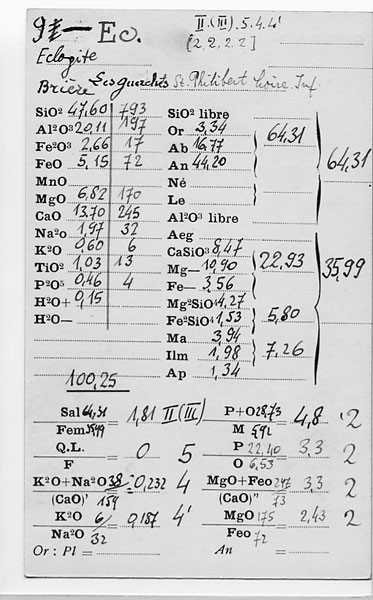
COSEM Q4 A "coronite" is a rock in which new metamorphic minerals have formed in a ring around a previous crystal. Here, the white plagioclases are no longer stable under increasing pressure and are nibbled away by small red garnets, marking the start of eclogitisation (the transformation into eclogite). Later, the garnets will grow as the plagioclase resorbs. Eventually, the coronites disappear to give the final garnet and pyroxene eclogite (COSEM B338).
COSEM B338 In this extraordinary Grytting outcrop, described by Eskola (1921), the clinopyroxenes (omphacites: rich in Na and Al) are green while the garnets (pyropes: rich in Mg) are red, and are sometimes of gem quality. The presence of honey-coloured orthopyroxene (enstatite: Mg-rich) indicates an overall chemical composition of the rock that is rich in magnesium. The absence of phlogopite mica (rich in Mg and water) indicates that this rock is relatively anhydrous.
The presence of orthopyroxene in an eclogite is very rare, except in association with peridotites. © D.C. SMITH
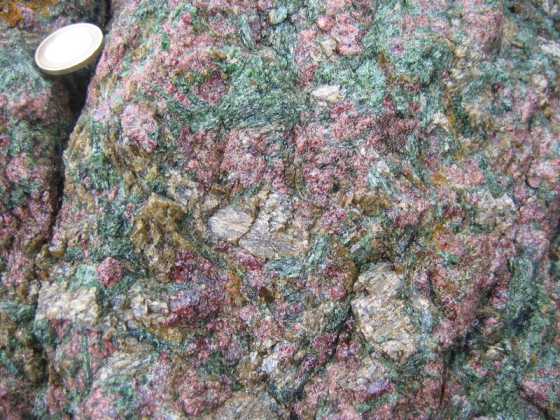
Books on display:
- Lacroix, A. (1891). - Etude pétrographique des éclogites de la Loire-inférieure, Bulletin of the Society of Natural Sciences of Western FranceI, pp. 81-114
Alfred Lacroix (1863-1948) was a French geologist, mineralogist and petrographer, who in 1893 was appointed Professor at the Muséum National d'Histoire Naturelle, to the chair of Mineralogy that René-Just Haüy had held seventy years earlier. In this 1891 article, he describes eclogites from various deposits in Loire-Atlantique, including Saint-Philibert-de-Grand-Lieu.
The author of more than six hundred publications, his work includes Mineralogy of France and its colonies: physical and chemical description of minerals; study of the geological conditions of their depositspublished between 1893 and 1913.
- Brière, Y. (1920). - Les éclogites françaises, leur composition minéralogique et chimique ; leur origine, Thèse ès Sciences naturelles, Paris, Giard et Brière, 143 p.
Yvonne Brière (1891-1981) joined the Muséum d'Histoire Naturelle and Alfred Lacroix's mineralogy laboratory, which had studied the eclogites of Loire-Atlantique. She proposed to extend the study to other French deposits as part of her thesis, as she wanted to "study eclogites, not only from the point of view of their mineralogical composition and structure, but also from that of their chemical composition, which makes it possible to discuss their probable origin". According to Brière, eclogites are of metamorphic origin and "have the chemical composition of eruptive, dioritic or gabbroic rocks, depending on the case. There is therefore little doubt that they originate from the transformation of rocks of this nature". This hypothesis was contested when she defended her thesis in 1919 at the Sorbonne, as many attributed a magmatic origin to eclogites, and the debate continued in the years and even decades that followed.
Yvonne Brière's thesis was also published in the Bulletin of the French Mineralogical SocietyVol. 43-2, 1920, available here : https://www.persee.fr/doc/bulmi_0366-3248_1920_num_43_2_3743
To find out more:
on Yvonne Brière and the debates surrounding the metamorphic origin of eclogites:
- Godard, G. (2001). - History of eclogites and their geodynamic interpretation, Works of the French Committee for the History of GeologyT. XV
- Godard, G. (2015). - (Ultra) high pressure metamorphism: two centuries of debate, Geochronicn°136, pp. 21-26
3. METAMORPHISM

Metamorphism is the transformation of rocks into a solid state when they are buried several kilometres below the surface as a result of geodynamic phenomena. Metamorphism is therefore a process that affects all rock families (magmatic, sedimentary and metamorphic) under the action of high temperatures and pressures at depth. There are several types of metamorphism: subduction/collision metamorphism during the formation of major mountain ranges (see display cases 5 & 6), contact metamorphism (e.g. around a pluton (see Flamanville), impact metamorphism (for example when a meteorite falls) and hydrothermal metamorphism (or metasomatism). see window 10).
The showcase displays different sedimentary and magmatic rocks (limestone, granite, clay, basalt and gabbro) and their metamorphic equivalents (marble, gneiss, micaschist and eclogite). During metamorphism, for example, basalts or gabbros (which are magmatic rocks in the oceanic crust) are transformed into eclogites under the effect of pressure, temperature and depth. These "pairs" of rocks (e.g. limestone/marble) have the same chemical composition (but different minerals).
To find out more:
- The different types of rock
- Bouton, P., Roy, C., Viaud, J.-M. (2020). - Curiosités géologiques des plaines et bocages de Vendée, Orléans, BRGM Editions, 120 p.
Available from the SGF shop: https://www.geosoc.fr/boutique-en-ligne/curiosit%C3%A9s-g%C3%A9ologiques/curiosit%C3%A9s-g%C3%A9ologiques-des-plaines-et-bocages-de-vend%C3%A9e-detail.html
- Collective (2015). - Regards croisés sur le métamorphisme, Geochronic136, pp. 7-82
Available from the SGF shop: https://www.geosoc.fr/boutique-en-ligne/geochronique/regards-crois%C3%A9s-sur-le-m%C3%A9tamorphisme-detail.html
- Nicollet, C. (2015). - Métamorphisme et géodynamique, Paris, Dunod, 301 p.
- Robert C., Bousquet, R. (2013). - Geosciences: the dynamics of the Earth system, Paris, Belin, 1159 p.
Available from the SGF shop: https://www.geosoc.fr/boutique-en-ligne/nouveaut%C3%A9s/g%C3%A9osciences-la-dynamique-du-syst%C3%A8me-terre-detail.html
4. NOTION OF FACIES
When a rock is subjected to particular conditions of pressure (P) and temperature (T) during metamorphism, it retains the same overall chemical composition but the minerals of which it is composed change. For example, a basalt (or gabbro) has the same chemical composition as an eclogite, but these rocks were not formed under the same P-T conditions. Depending on these conditions, a distinction is made between what are known as metamorphic "facies".

In 1911, Victor Goldschmidt studied a metamorphic rock formation in Norway and established for the first time a link between the equilibrium mineralogical assemblage of a metamorphic rock and its overall chemical composition.

In 1915 in Norway, Pentti Eskola made the same observations. However, he found that certain metamorphic rocks with the same chemical composition had different mineralogical assemblages. He concluded that the difference between these assemblages reflected crystallisation under different PT conditions. He then defined the concept of facies in 1920 (even though he considered eclogites to be of magmatic origin).
Experimental confirmation of the formation of HP eclogites, and therefore of their deep-seated origin, came in the 1960s with the development of experimental petrology (Smulikowski, 1964; Coleman et al., 1965; Ringwood and Green, 1966; Newton and Smith, 1967).
The names of the 5 main metamorphic facies - greenschist (SV), blueschist (SB), amphibolite (AMPH), granulite (GRANU) and eclogite - correspond to the P-T domains defined for rocks of basaltic composition and are presented in this showcase. The presence (and absence) of certain minerals is characteristic of certain facies: blue amphibole (glaucophane) for the blue schist facies, garnet-pyroxene assemblage (+ absence of plagioclase) for the eclogitic facies (see list of characteristic minerals).


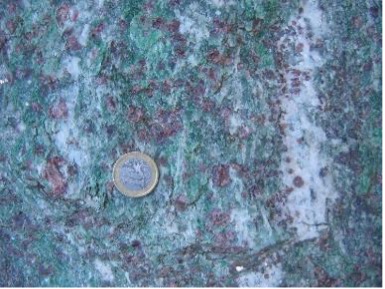
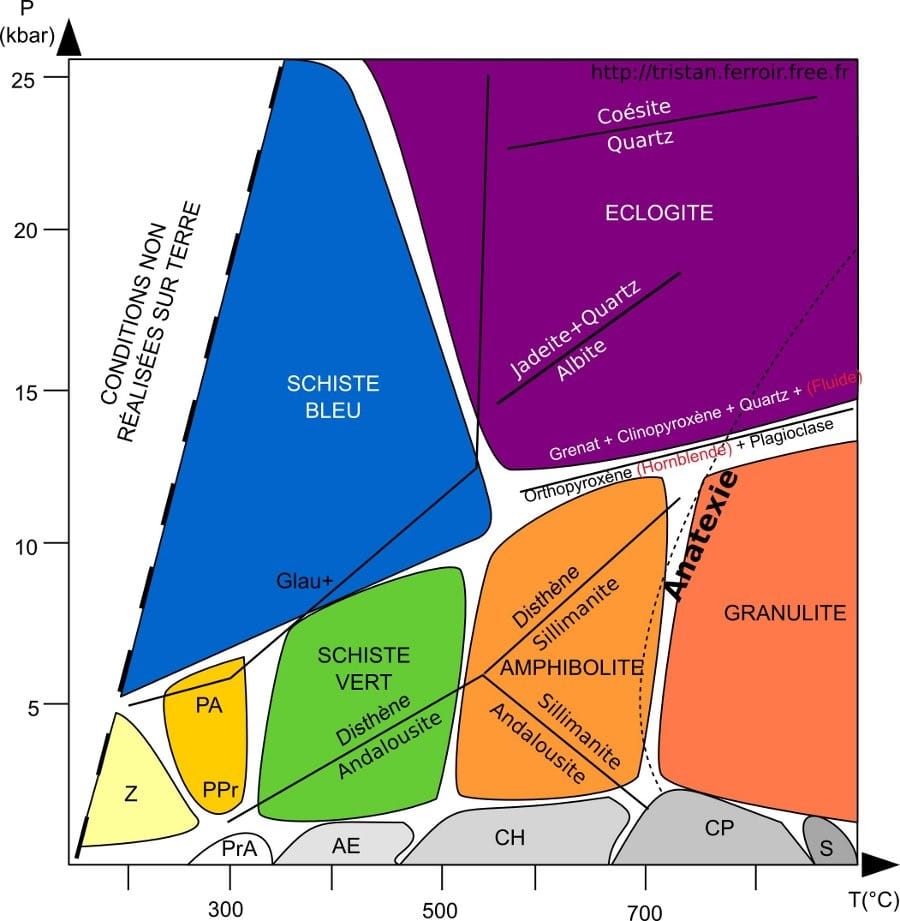
Main facies minerals (for a basic rock) :
Green schist albite (white), chlorite and actinote (green) ± epidote (green)
Blue shale glaucophane (blue) and epidote (pistachio-green) ± garnet (red) ± lawsonite
Amphibolite amphibole (dark green), plagioclase (white) ± garnet (red)
Granulite quartz (colourless), feldspars (white and pink) ± hypersthene (dark honey), garnet (red)
Eclogite pyroxene (green: omphacite/jadeite) and garnet (red)
© T. Ferroir
Book on display:
- Eskola, P. (1920). - The mineral facies of rocks, Norsk Geologisk TidsskriftVI, pp. 143-194.
Pentti Eskola (1883-1964) was a Finnish geologist who developed the concept of metamorphic facies. The first traces of this concept can be found in two of his publications in 1914 and 1915: "In any metamorphic rock that has reached chemical equilibrium through metamorphism under conditions of constant temperature and pressure, the composition of the minerals is controlled solely by the chemical composition [of the rock]". Eskola expanded on his idea in the following years (thanks in part to his meeting with Victor Goldschmidt) and proposed a classification of metamorphic facies in 1920.
To find out more:
- Eskola, P. (1914). - On the petrology of the Orijärvi region in southwestern Finland, Bulletin of the Geological Survey of Finland, 40, 277 p.
- Eskola, P. (1915). - Om sambandet mellan kemisk och mineralogisk sammansattning hos Orijarvi-traktens metamorfe bergarter [On the relations between the chemical and mineralogical composition in the metamorphic rocks of the Orijarvi region], Bulletin of the Geological Survey of Finland44, pp. 109-145.
- Eskola, P. (1929). - Om mineralfacies. Geologiska Foreningens i Stockholm Forhandlingar51, pp. 157-172.
- Plunder, A. (2013). - The evolution of the concept of metamorphic facies under the influence of Pentti Eskola between 1915 and 1939, Works of the French Committee for the History of GeologyT. XXVII
- Smulikowski, K. (1964). The eclogite problem. Geologia Sudetica, 1(1), 13-77.
- Coleman, R. G., Lee, D. E., Beatty, L. B., & Brannock, W. W. (1965). Eclogites and eclogites: their differences and similarities. Geological Society of America Bulletin, 76(5), 483-508.
- Ringwood, A. E., & Green, D. H. (1966). An experimental investigation of the gabbro-eclogite transformation and some geophysical implications. Tectonophysics, 3(5), 383-427.
- Newton, R. C., & Smith, J. V. (1967). Investigations concerning the breakdown of albite at depth in the earth. The Journal of Geology, 75(3), 268-286.
Find out more about the eclogites from the island of Groix on display:
- Graviou, P., Jégouzo P., Jonin, M., Plaine, J. (2014). - Bretagne, Guides géologiques, Montreuil, Omniscience, 256 p.
Available from the SGF shop: https://www.geosoc.fr/boutique-en-ligne/guides-g%C3%A9ologiques/guides-g%C3%A9ologiques-bretagne-detail.html
- Graviou, P., Augier, R., Le Goff, E. (2019), Curiosités géologiques du Morbihan, Orléans, BRGM Editions, 120 p.
Available from the SGF shop: https://www.geosoc.fr/boutique-en-ligne/curiosit%C3%A9s-g%C3%A9ologiques/curiosit%C3%A9s-g%C3%A9ologiques-du-morbihan-detail.html
- Michel Ballèvre. The island of Groix: an archive of Paleozoic subductions. Geochronic2022, 163, pp.10-13. ⟨insu-03822077⟩
5. LANDFILL
During burial by subduction, the oceanic plate composed of basalt and gabbro and its clayey, sandy or carbonate sedimentary cover plunges under a continental or oceanic plate, resulting in a more rapid increase in pressure than in temperature.
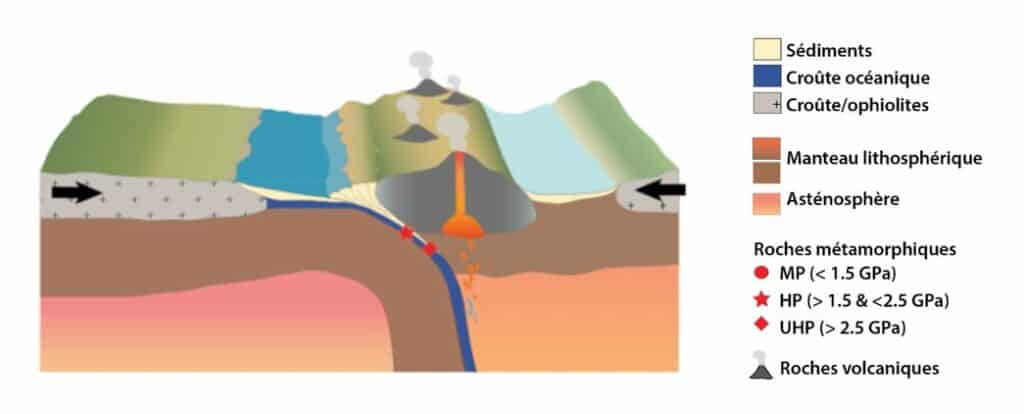

COSEM S14 Blue shale: This rock comes from a lens of eclogite embedded in a unit of blue shale; these two types of rock were created under high pressure. The name blue schist is given to these rocks because they contain a violet-blue amphibole called glaucophane.
COSEM N11 This rock was a calcschist (schist of calcareous and clayey origin) but during the Alpine orogeny (= formation of the mountain range), it was metamorphosed (under static conditions) into an eclogitic facies and now contains large omphacite crystals and beautiful garnets intersecting the pre-existing foliation.
COSEM MV8 The white minerals (plagioclases) of the original gabbro became white minerals (zoïsites) of the eclogitic facies. Smaragdite (from Latin smaragdus which means emerald) is a sodic emerald-green clinopyroxene (omphacite) that is also rich in chromium (Cr).
COSEM C51 br In this very high-pressure rock, micro-inclusions of coesite (a mineral composed of SiO2) are too small to be seen with the naked eye. Coesite is the equivalent of quartz (both minerals have the same chemical composition, i.e. SiO2) but coesite forms at higher pressures (> 25 kbar, see window 12).
To find out more : The unit used in geology for pressure is the kilo bar (kbar) or the Giga Pascal (GPa). 1GPa=10 kbar. Normal atmospheric pressure is approximately 1 bar.
6 EXHUMATION
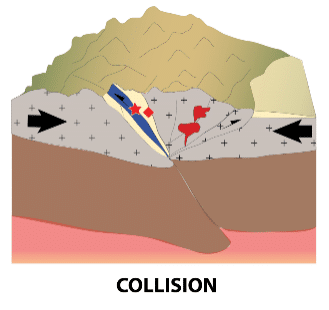
After a subduction event, exhumation takes place as a result of major thrusting in compressional zones, continental collision zones (e.g. the collisions between India and Asia to create the Himalayas, or between Africa and Europe to create the Alps) or in metamorphic domes, known as Metamorphic Core Complexes (e.g. Tinos, Naxos in the Cyclades, Greece) where metamorphic rocks of deep origin rise up through normal faulting in extensional zones.
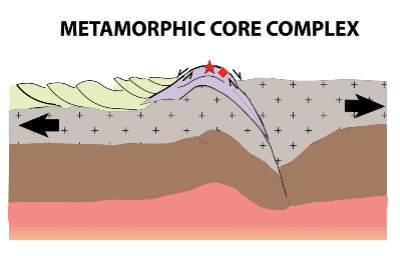
F/167 & F/166 These two rocks are blue schists retromorphosed (= transformed back into green schists during exhumation). Blue glaucophane and green epidote can be seen, and red garnet on sample F/166.
215.19 These are coronite rocks where the garnet begins to be eaten away by crowns of amphibole and where the sodium pyroxene, omphacite, destabilises into symplectites (= a particular texture where there is an intergrowth of 2 or more mineral phases, formed from pre-existing unstable phases) with diopside and sodium plagioclase (albite).
COSEM G202 As a result of reduced pressure during exhumation, a red-green-white eclogite such as sample G202 is transformed into a black-grey-white amphibolite by retromorphosis (linked to the presence of mica, clinoamphibole and plagioclase), particularly towards the edges of the lens, which is in contact with the surrounding gneisses (see window 8).
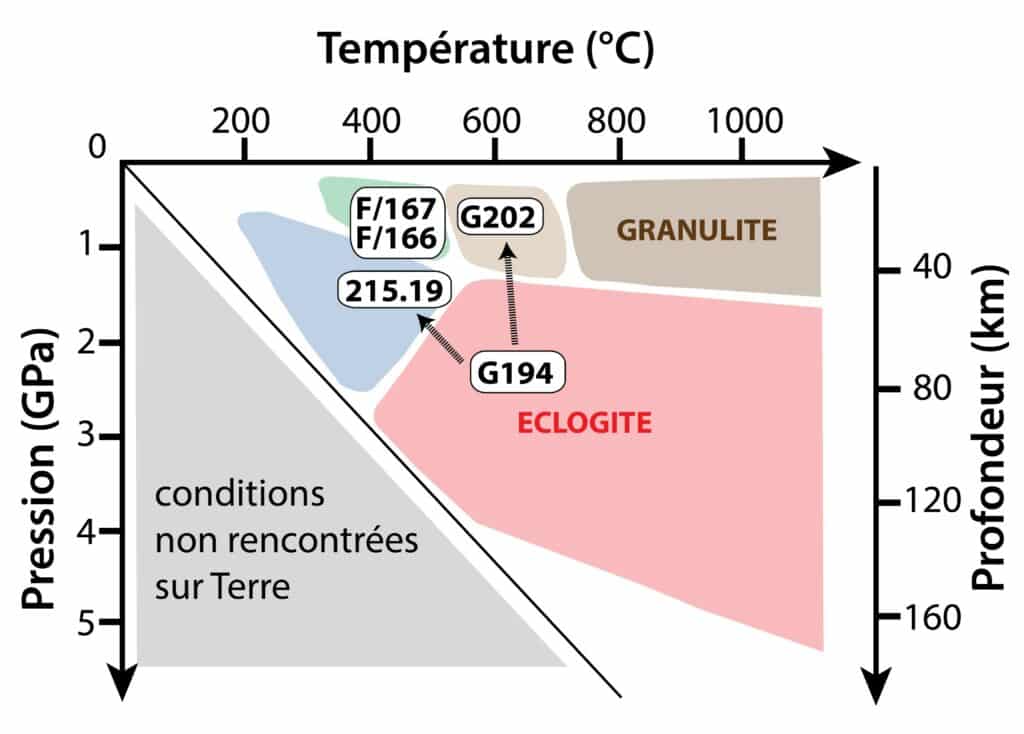
COSEM G194 Eclogites whose overall chemical composition is rich in aluminium (Al) and calcium (Ca) contain zoïsite. Here we see white zoïsite, and the garnets and clinopyroxenes are darker than usual because they are richer in iron (Fe).
7. RARE SAMPLES
COSEM S21 The amphibole known as glaucophane was first discovered on the island of Syros (Greece). This locality is known as the "type locality" for glaucophane. The term comes from the ancient Greek γλαυκός (medium green to blue) or from the Latin glaucus (pale blue/grey) and phanein, to shine. Nice glaucophane prisms can be seen on the surface of this sample.
COSEM G103 Eclogites are often found in Norway where the two main minerals, garnets and clinopyroxenes, are segregated (= separated) in layers. Several mechanisms have been suggested to explain this phenomenon, such as: 1. the original rock was a bedded gabbro, or 2. under the effect of deformation, the clinopyroxene prisms slid while the rounder garnet grains rolled, gradually separating them (Smith, 1976).
COSEM G128 In general, in Norwegian eclogites, clinoamphibole grains (which are quite black and can be stable in eclogite facies) are generally small. Here, it is exceptional to observe beautiful centimetric crystals of clinoamphibole.
To find out more:
- Smith D. C. (1988). - A review of the peculiar mineralogy of the "Norwegian coesite-eclogite province", with crystal-chemical, petrological, geochemical and geodynamical notes and an extensive bibliography, In: Smith, D. C. (Ed.), Eclogites and Eclogite-Facies Rocks, Developments in Petrology9, Amsterdam, Elsevier, pp. 1-206
8 The "Western Gneiss": Encasing eclogites
The "Western Gneiss Region" (WGR) is an enormous mountainous geological unit over 300 km long (north-south) and over 100 km wide (east-west) in the south-western part of Norway (with narrower parts outcropping in the north of the country) near the Atlantic coast (see geological maps shown). These gneisses are mainly Precambrian rocks (older than 540 million years, or Ma), of various origins, which were metamorphosed during the "Caledonian" orogeny (around 420 Ma) when the continental blocks known as "Laurentia" (North America and Greenland) and "Baltica" (Scandinavia and Russia) collided (to find out more: https://www.youtube.com/watch?v=v7KtuqDaPV0). These gneisses were then split in two by the opening of the Atlantic Ocean, with the result that part of them now outcrops on the east coast of Greenland.
These fairly diverse gneisses are often banded. The leucocratic (whitish) zones are rich in feldspars and the melanocratic (blackish) zones are rich in clinoamphiboles and/or biotites. Magnetite is the most common "accessory" mineral. These ribbons are highly folded (sometimes isoclinal). Sometimes these rocks are sheared, cut by veins or partially melted, and are generally considered to have been metamorphosed in the amphibolite facies where the plagioclase + clinoamphibole pair predominates. Depending on the mineral species present and their texture, these gneisses are called, for example: dioritic or granodioritic gneiss; garnet amphibolite; garnet micaschist; kyanite or sillimanite amphibolite.
Within this large WGR unit, the Norwegian eclogites outcrop in the form of boudins or, more often, lenses (known as "lenses" or "pods" in English). These lenses can range in length from just a few centimetres to over a kilometre! The WGR gneisses also contain lenses of peridotite (a rock from the Earth's mantle) and sometimes anorthosite.
These eclogites are always retromorphosed in the amphibolite facies, especially at the edge of lenses in contact with the surrounding gneiss: the red and green colours of fresh eclogites change to dark green to black due to the formation of retrograde clinoamphiboles (=formed during retromorphosis; commonly called "hornblende", but sometimes there are other species such as pargasite etc.). These "amphibolitized eclogites" are composed of several types of symplectite (intercroissances of two or more mineralogical phases in very small grains that replace the previous mineral phase); the most characteristic symplectites are composed of {clinoamphibole + plagioclase} after the disappearance of clinopyroxene, or {clinoamphibole + magnetite} after the disappearance of garnet. Over time, the very small grains recrystallise into larger ones.
The percentage of amphibolitisation in a "fresh" eclogite can vary from 100 % at the contact with the host gneisses (which provided the water necessary for the recrystallisation of the clinoamphiboles) to 0 % at the centre of the lens where "pristine" eclogites are often seen. These rocks can be used to calculate the pressures and temperatures required for their crystallisation into eclogite facies, reflecting their subduction depth.


Lite gneiss of varied colour with several lenses of basic rocks (eclogites and amphibolites) of varying size and shape. © D.C. SMITH
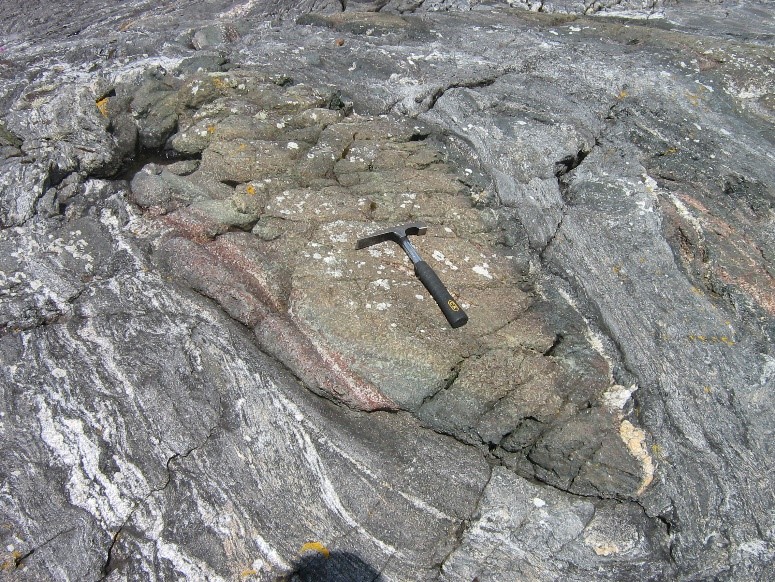

Eclogite lens showing an amphibolitized zone (dark grey) at its edges in contact with the host gneiss © D.C. SMITH


Aeolitic gneiss with deformed pink feldspar and gneiss with epidote veins © D.C. SMITH
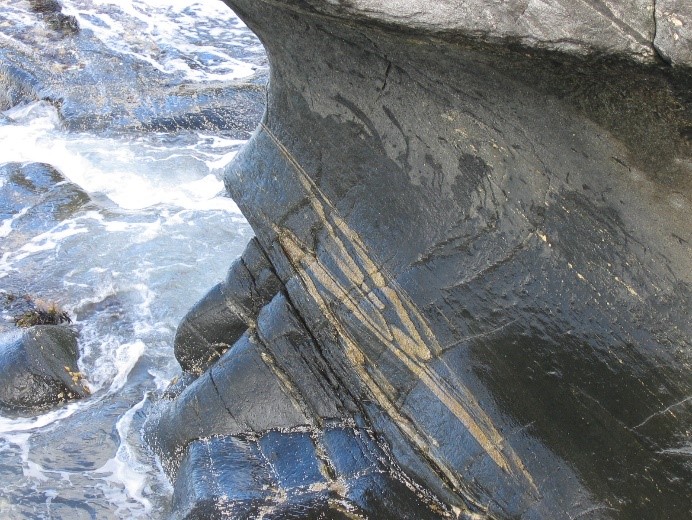
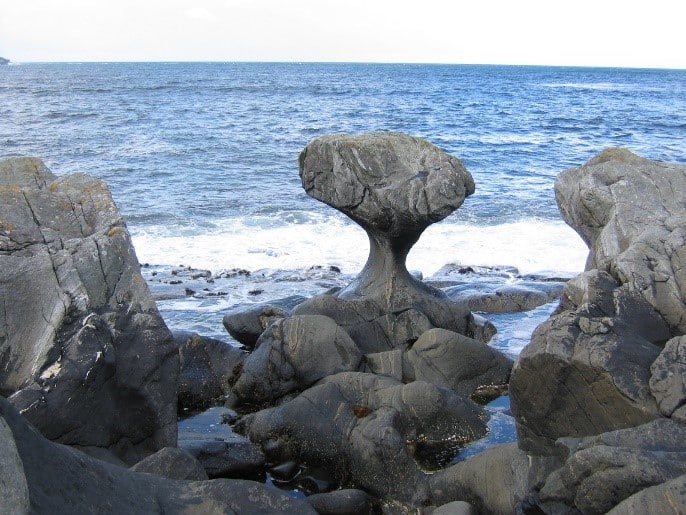
Gneiss folded into isoclines (fold axes parallel to each other) and gneiss eroded by the sea! © D.C. SMITH
Books on display:
- Bryhni, I. (1966). - Reconnaissance studies of gneisses, ultrabasites, eclogites and anorthosites in Outer Nordfjord, Western Norway, Norsk Geologisk Undersökelse, 241, 68 p.
- Lappin, M. A. (1966). - Field relationships of basic and ultramafic masses in the basal gneiss complex of Stadlandet and Almklovdalen, Nordfjord, southwestern Norway, Norsk Geologisk Tidsskrift, 4pp. 439-496.
To find out more:
- Gjelsvik, T. (1951). - Oversikt over bergartene i Sunnmøre og tilgrensende deler av Nordfjord, Norges geologiske undersøkelseNr. 179, 45 p. + 1 map
- Hacker, B. R., Andersen, T. B., Johnston, S., Kylander-Clark, A. R., Peterman, E. M., Walsh, E. O., & Young, D. (2010). High-temperature deformation during continental-margin subduction & exhumation: The ultrahigh-pressure Western Gneiss Region of Norway, Tectonophysics480(1-4), pp. 149-171.
9. ULTRABASIC ECLOGITES
The rocks of the Earth's mantle are ultrabasic, i.e. low in silica (SiO2<45%), and mainly composed of minerals rich in iron (Fe) and magnesium (Mg) such as olivine, clinopyroxene and orthopyroxene. The relative proportions of these three phases determine the different names of mantle rocks: dunite, peridotite, lherzolite, harzburgite, wehrlite, etc.
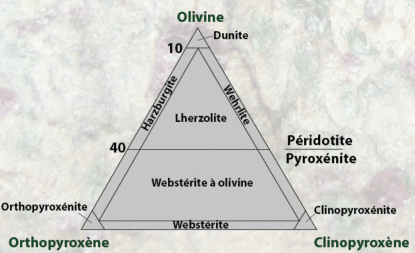
These rocks formed in the Earth's mantle before being incorporated into the WGR. In the eclogitic facies, aluminous phases such as plagioclase and spinel are transformed into garnet at pressures approaching or exceeding 30 kbar, a pressure corresponding to a depth of more than 120 km, the distance between Paris and Orléans! (Mercy & O'Hara, 1965; Medaris, 1980; Carswell, 1981; Cordellier et al., 1981), and graphite into diamond (Vrijmoed et al., 2008). The sample COSEM C35 is a chromite dunite, a spinel rich in chromium (Cr). Sometimes clinopyroxene takes on a brighter green colour, due to its Cr content (sample COSEM R61a).
These ultrabasic rocks can be very fresh, pale green in colour (R61a), or dark green because they are retromorphosed when the pressure is reduced during exhumation. Olivine is transformed into serpentine by hydration, giving the rock a darker colour. On the other hand, meteoric alteration (alteration mainly due to rainwater and wind) at low surface temperatures produces a thin rust-coloured layer (COSEM R55).
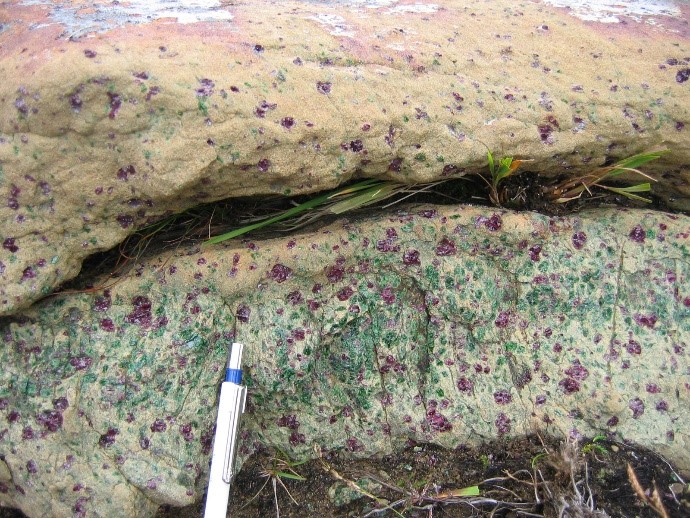
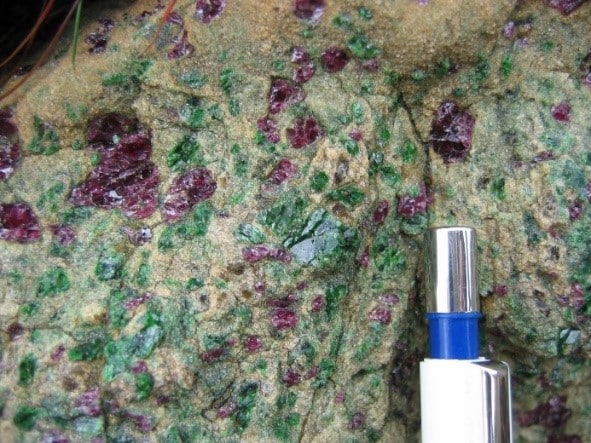
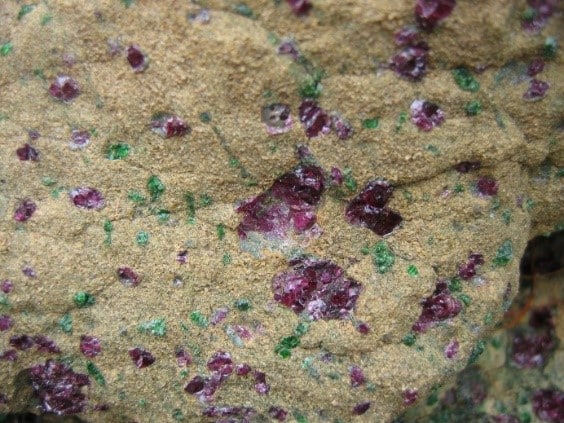
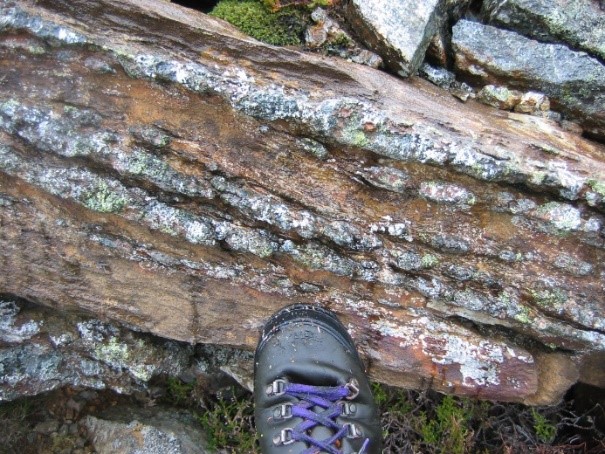
To find out more:
- Mercy, E. L. P., O'Hara, M. J. (1965). - Chemistry of some Garnet bearing rocks from south Norwegian peridotites, Norsk Geologisk Tidsskrift45, pp. 323-332.
- Medaris Jr, L. G. (1980). - Petrogenesis of the Lien peridotite and associated eclogites, Almklovdalen, western Norway, Lithos13, pp. 339-353.
- Carswell, D. A. (1981). - Clarification of the petrology and occurrence of garnet lherzolites, gamet websterites and eclogite in the vicinity of Rödhaugen, Almklovdalen, West Norway, Norsk Geologisk Tidsskrift61, pp. 249-260.
- Cordellier, F., Boudier, F., Boullier, A. M. (1981). - Structural study of the Almklovdalen peridotite massif (southern Norway), Tectonophysics77(3-4), pp. 257-281
- Vrijmoed, J. C., Smith, D. C., Roermund, H. L. M. van (2008). - Raman Confirmation of Microdiamond in the Svartberget Fe-Ti type garnet peridotite, Western Gneiss Region, Western Norway, Terra Nova20(4), pp. 295-301
- Visit the Earth's internal structure
10. REACTION BETWEEN GNEISS AND ULTRABASICS
When a lens of peridotite is found within a gneiss unit such as the WGR, there are strong chemical contrasts between peridotite rich in Mg and Fe and poor in Si, Al, Ca, Na and H2O, and the surrounding gneiss, which have opposite chemical characteristics. During retromorphosis, ion-laden fluids circulate in the rocks, modifying their overall chemical composition, a process known as "metasomatism". This type of metamorphism (with the addition of fluids) involves recrystallisation (in an open system), creating a contact zone whose chemistry differs from that of the initial gneiss and peridotite. These reaction bands, often monomineral (composed of a single mineral), are called "skarns".
Metasomatism can create new monomineral rocks, such as the three samples in the showcase, collected at the edge of a peridotite. Rocks dominated by talc (COSEM B349called talcite or steatite), actinote amphibole (COSEM B354), and finally biotite mica (COSEM B356called biotitite). The latter has a crenulation texture (micro-folds formed during deformation).
COSEM C142 This black rock, which looks like a lump of coal, outcrops at the edge of another peridotite that has been strongly hydrated by fluids from the surrounding gneisses.
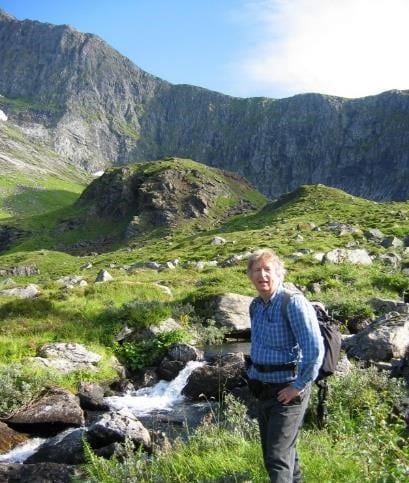
The honey-beige mound (behind David) is a peridotite that has been partially metasomatised to form the rock composed of black amphibole (COSEM C142). Omnen locality, Norway © D.C. SMITH
11. MAGNESIAN ECLOGITES and the origin of UHPM
Eclogites with an overall composition rich in magnesium (Mg) and little hydration contain orthopyroxene, generally close to the enstatite pole and yellowish brown in colour. If, on the other hand, they are more hydrated, phlogopite mica appears; its colour is brown in thin sheets, and black in the rock. At Grytting, which has become famous since its description by Eskola (1921), eclogite crystals are quite large, sometimes 2 cm long, and with bright red (garnet) and green (clinopyroxene) colours. This rock was so prized for sale that the authorities had to prohibit any further harvesting (fortunately, David Smith and his colleague Michael Lappin had already collected their samples several years earlier!)
By studying these rocks, Smith (1976) and Lappin & Smith (1978) were able to analyse in detail the distribution of the elements Al, Mg and Fe between the different phases and thus calculate the crystallisation pressure of this paragenesis (association of minerals at equilibrium for a given pressure and temperature) stable between 30 and 40 kbar (i.e. a depth of more than 120 km). These values correspond to ultra-high pressure metamorphism (UHPM), before the discovery of coesite (see window 12). At the time, many geologists refused to believe in these ultra-high pressures. A few years later, David Smith discovered another phase in the same lens: magnesite. Recalculations by Lappin & Smith (1981) again indicated these ultra-high pressures and, little by little, the world's geologists finally accepted the concept of UHPM, reinforced by the discoveries of coesite in Italy and Norway in 1984 (see windows 12 & 13).
Subsequently, eclogites created under very high pressure were described in several other countries (e.g. China, Greece, Kazakhstan), leading to the creation of a new sub-discipline in metamorphism: UHPM (Ultra High Pressure Metamorphism). Since then, diamond, another ultra-high pressure phase, has been discovered in eclogites from several countries in the form of micro-inclusions preserved in zircons (e.g. in Kazakhstan: Shatsky et al, 1989; in Norway: Vrijmoed et al., 2008).
These discoveries revealed burial depths during subduction of more than 140 km, revolutionising our beliefs about the burial process.

In the magnificent fresh coarse-grained orthopyroxene eclogite described by Eskola (1921), there are large deep cavities (where a man stands), probably not eroded by the sea next door, but blasted by collectors. The black spots are lichens. Grytting, Selje, Norway © D.C. SMITH
In the hydrated parts of this outcrop, orthopyroxene is often replaced by phlogopite (black with small grains in the centre and larger grains at the top). Sometimes the garnets are large and of gem quality. Grytting, Selje, Norway © D.C. SMITH
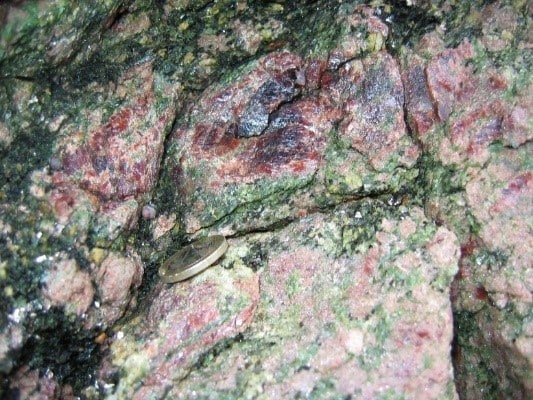
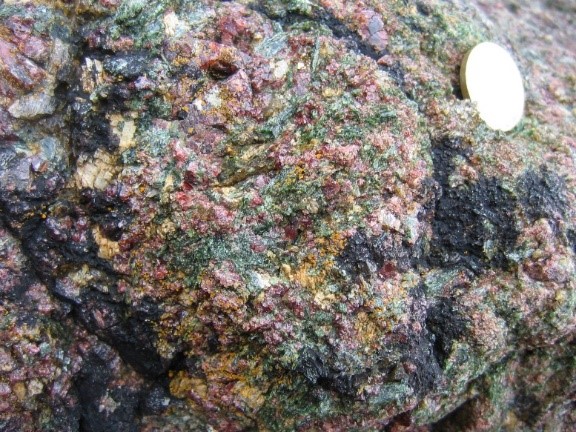
In this same honey-coloured orthopyroxene eclogite, there are other, smaller grains of almost the same colour. This is magnesite (Mg carbonate), first described by Smith (1976). The black parts are lichens. Grytting, Selje, Norway © D.C. SMITH
Amphibolitisation of an eclogite (right: the dark green and white anthophyllite zone) and fresh eclogite (left: the inner zone showing honey-yellow-brown orthopyroxene, bright green clinopyroxene and red garnet) Grytting, Selje, Norway © D.C. SMITH
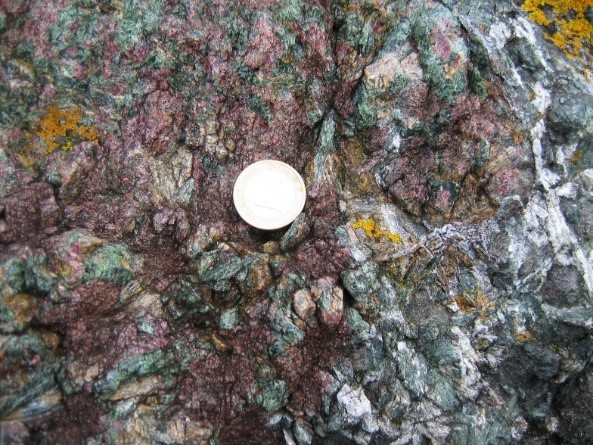
Book on display:
- Eskola P. (1921). - On the eclogites of Norway, Videnskapsselskapets Skrifter, I- Mathematisk-Naturvidenskapelig Klasse, (8), 118 p.
To find out more:
- Smith, D. C. (1976). - The geology of the Vartdal Area, Sunnmöre, Norway, and the petrochemistry of the Sunnmöre Eclogite Suite, D. thesis, Aberdeen University, 750 p.
- Lappin, M. A., Smith D. C. (1978). - Mantle-equilibrated orthopyroxene eclogite pods from the Basal Gneisses in the Selje District, Western Norway, Journal of Petrology19, pp. 530-584
- Lappin, M. A., Smith D. C. (1981). - Carbonate, silicate and fluid relationships in eclogites, Selje District and environs, SW Norway, Transactions of the Royal Society of Edinburgh, Earth Sciences72, pp. 171-193
- Shatsky, V. S., Sobolev, N. V., Vavilov, M. A. (1995). - Diamond-bearing metamorphic rocks of the Kokchetav massif (Northern Kazakhstan), In : Coleman, R. G., Wang X. (Eds.), Ultrahigh Pressure Metamorphism, Cambridge, Cambridge University Press, pp. 427-455
- Vrijmoed, J. C., Smith, D. C., Roermund, H. L. M. van (2008). - Raman Confirmation of Microdiamond in the Svartberget Fe-Ti type garnet peridotite, Western Gneiss Region, Western Norway, Terra Nova20(4), pp. 295-301
- Sobolev, N. V. (1987). Carbon mineral inclusions in garnets of metamorphic rocks. Anuarul Institutului de Geologie si Geofizica, 7, 77-80.
- Sobolev, N. V., & Shatsky, V. S. (1990). Diamond inclusions in garnets from metamorphic rocks: a new environment for diamond formation. Nature, 343(6260), 742-746.
- Korsakov, A. V., Perraki, M., Zedgenizov, D. A., Bindi, L., Vandenabeele, P., Suzuki, A., & Kagi, H. (2010). Diamond-graphite relationships in ultrahigh-pressure metamorphic rocks from the Kokchetav Massif, Northern Kazakhstan. Journal of Petrology, 51(3), 763-783.
12 Siliceous and/or aluminous ecologites and the UHPM
SILICK ECLOGITES: COSEM R49 & COSEM C51gt
Eclogitic facies rocks contain not only garnet and clinopyroxene, but also accessory minerals such as rutile, apatite and/or zircon. The presence of an excess of silicon (Si) at around 20 kbar pressure (at a depth of around 65 km) allows quartz to form, which is very common in eclogites around the world, as in the famous Verpeneset outcrop (R49).
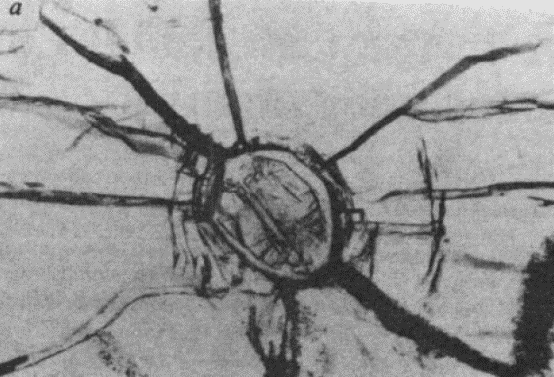
Under the effect of pressure (and therefore depth), quartz is transformed into coesite (the very high-pressure "polymorph" of SiO2) from around 30 kbar. This mineral is characteristic of ultra-high pressure metamorphism (UHPM).
Coesite (centre) surrounded by a thin zone of late quartz included in a clinopyroxene which shows radial fractures related to decompression during exhumation. COSEM C51gt from Grytting. © D.C. SMITH
Diagram showing the different polymorphs of SiO2 as a function of pressure and temperature.
© 2005-2013, A.C. Akhavan
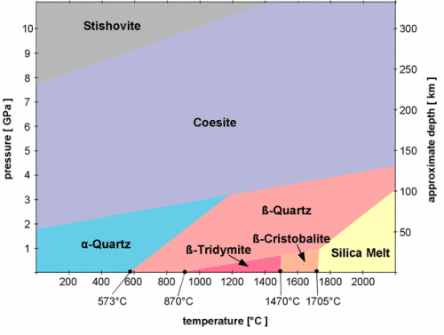
In Norway, coesite was first discovered in 1984 throughout the Caledonian orogen by David Smith at Grytting (C51shown here as a drill core). By an incredible coincidence, this first lens of coesite eclogite is located 10 cm from the famous orthopyroxene eclogite from Eskola (1921) mentioned in showcase 11. Coesite had also been discovered in the Italian Alps by Christian Chopin (1984) a few months earlier. These coesites in micro-inclusions in garnets or clinopyroxenes testify to the burial of surface rock during the subduction process, at depths of more than 75 km, which was in itself a novelty. In addition, coesite in the Italian Alps was found in acid rocks (showcase 13), proving that granitic continental crust, which is less dense than oceanic basalts, can also subduct, which was a real paradigm shift in geodynamics (the study of the Earth's dynamics).
These coesite micro-inclusions were preserved during retromorphosis in the amphibolite facies by the hardness of the host mineral. However, radial or concentric fractures can be seen around the inclusions, linked to the increase in volume of the SiO2 during the coesite => quartz transition on decompression.

These photos come from Smith (1988) and show several examples of coesite included in clinopyroxene (Smith, 1984) or garnet (Smith & Lappin, 1989) (samples from Norway).
In some quartz eclogites, the three species of the paragenesis clinopyroxene + garnet + quartz are not always in contact, since one or other species may be missing locally, depending on the nature of the protolith (= rock before metamorphism). This is why we can find a simple eclogite, or a quartz clinopyroxenite, or a quartz grenatite like C263.
Bedded quartz eclogite, Verpeneset, Nordfjorden, Norway © D.C. SMITH
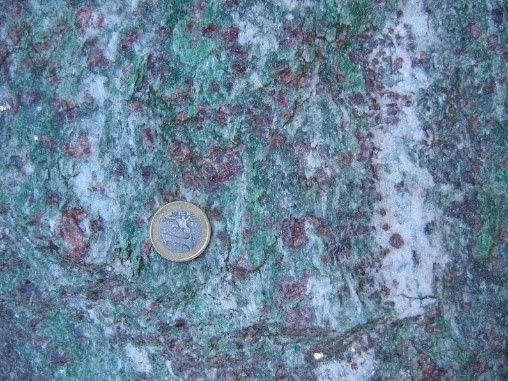
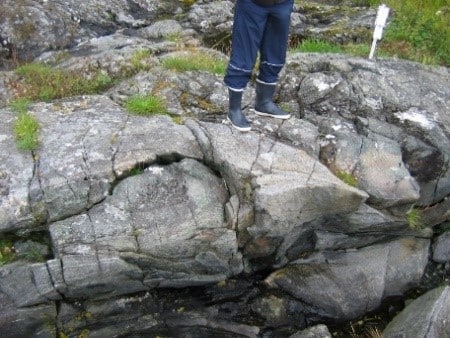
The first outcrops of Norwegian coesite (included in clinopyroxene: Smith (1984) were found in a partially amphibolitised eclogite in a complex grey zone composed of lenses of retrograde (blackish) eclogite separated by layers of smooth, folded and also grey gneiss (like the pale rock under the right boot). Grytting, Selje, Norway © D.C. SMITH
Norwegian coesite (included in garnet: Smith & Lappin,
1992) was also found in a quartz eclogite on the hilltop above Straumen.
above Straumen. Straumen, Sorpollen, Norway © D.C. SMITH

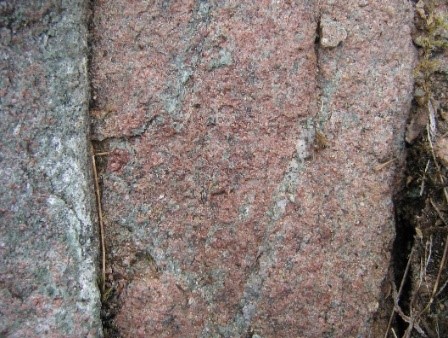
Garnet-rich eclogite with coesite. Straumen, Sorpollen, Norway © D.C. SMITH
ALUMINIUM-RICH ECLOGITES: COSEM F36 & COSEM N6
Aluminium (Al)-rich eclogites may contain one or more aluminous mineral species, such as kyanite (= cyanite) first found in a Norwegian eclogite by Lappin (1960), potassium-rich phengite mica (K + Al), or calcium-rich zoïsite (Ca + Al). The rock F36rich in phengite (high-pressure mica) and with a gneissic, almost schistose texture, was once a granite, eclogitised during the alpine orogeny. This is the rock in which David Smith discovered fluoroaluminous sphene (titanite), in which the {Ti+O} pair has been replaced by the {Al+F} pair. He carried out laboratory experiments in a piston cylinder up to pressures of 40 kbar showing that the {Al+F} content increased with pressure (Smith, 1981).
Disthenes and phengites are common in Norwegian, Italian and German eclogites. Their retromorphosis in amphibolite facies gives characteristic symplectites: {corundum + plagioclase} in place of kyanite and {biotite + plagioclase} in place of phengite.
In the particular locality of St. Marcel where the eclogitised rocks are very rich in manganese (Mn), the minerals take on purplish colours such as violane (Mn-rich diopside) or alurgite (Mn-rich phengite) (N6).
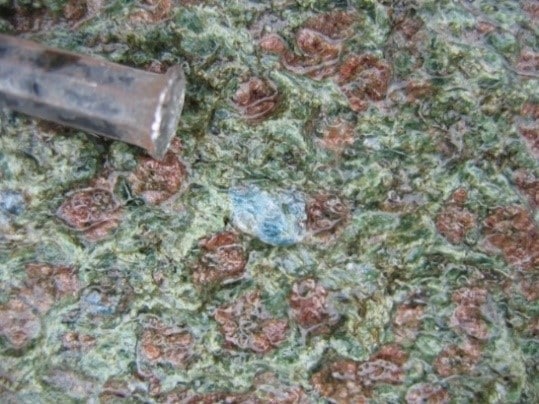
Disthene eclogite (cyanite) in blue. Maaloy Island, Norway © D.C. SMITH
To find out more:
- Eskola P. (1921). - On the eclogites of Norway, Videnskapsselskapets Skrifter, I- Mathematisk-Naturvidenskapelig Klasse, (8), 118 p.
- Smith, D. C. (1984). Coesite in clinopyroxene in the Caledonides and its implications for geodynamics, Nature310(5979), pp. 641-644.
- Lappin, M. A. (1960) - On the occurrence of kyanite in the eclogites on the Selje and Aheim districts, Nordfjord, Norsk Geologisk Tidsskrift, 40(3-4), pp. 289-296
- Smith, D. C. (1981). - The pressure and temperature dependence of Al-solubility in titanite in the system Ti-Al-Ca-Si-O-F, Progress in Experimental Petrology, NERC Publication Series D 18, pp. 193-197
- Smith, D. C., Lappin, M. A. (1989). - Coesite in the Straumen kyanite-eclogite pod, Norway, Terra Nova1, pp. 47-56
13 "ACID" ECLOGITES AND UHPM
The term "eclogite" is normally restricted to rocks with an overall basic chemical composition. However, when acidic (= silica-rich) rocks, such as granites or clays, are subjected to eclogitic facies conditions of pressure and temperature, these rocks are commonly referred to as acid eclogites, even if garnet or clinopyroxene are locally missing due to a lack of Mg or Fe.
At Dora Maira in the Italian Alps, there are some remarkable white micaschists (CC3whiteschists) containing garnet close to the pure magnesian pole (pyrope) and therefore colourless, but also kyanite, phengite, talc and rutile, as well as coesite (and late quartz).
Sometimes large single crystals of garnet are formed (DM22-32b & DM19-09). It was in such single crystals that Christian Chopin discovered in 1984 the micro-inclusions of coesite that are indicative of UHPM. In addition to coesite, these large pyropes contain micro-inclusions of several other phases: kyanite, talc, clinochlore, ellenbergerite and rutile (CC2).
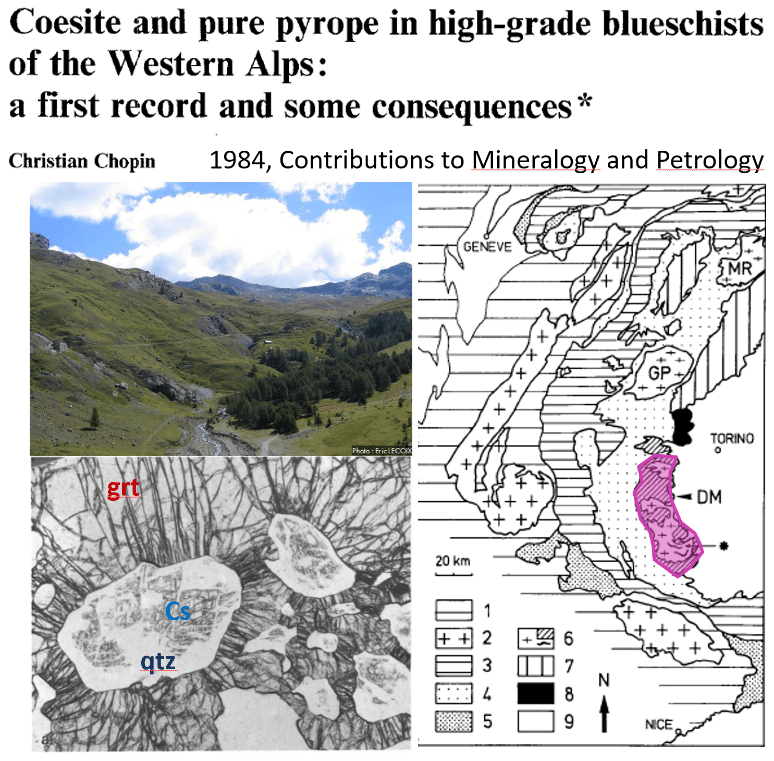
DM22-32b This sample is a whole garnet of decimetric size, with some crystallographic faces visible. Its pale pink colour is linked to its unusual chemistry, poor in iron and rich in magnesium, which can only be formed at temperatures above 700°C (on loan from Guillaume Bonnet).
DM19-09 This sample is a slice from a garnet equivalent to the previous sample. Among the many minerals included in these garnets, the presence of coesite makes it possible to estimate formation depths of around one hundred kilometres (on loan from Guillaume Bonnet).
The book is displayed in a window:
- Coleman, R. G., Wang, X. (1995). - Ultrahigh pressure Metamoprhism, Cambridge, Cambridge University Press, 528 p.
Find out more:
- Chopin, C. (1984). - Coesite and pure pyrope in high-grade blueschists of the Western Alps: a first record and some consequences. Contributions to Mineralogy and Petrology86, pp. 107-118.
- Michard, A., Henry, C., Chopin, C. (1995). - Structures in UHPM Rocks: a case study from the Alps, InUltrahigh pressure Metamoprhism, Cambridge, Cambridge University Press, pp. 132-158
- Compagnoni, R., Hirajima, T., Chopin, C. (1995). - Ultra-high pressure metamorphic rocks in the Western Alps, InUltrahigh pressure Metamoprhism, Cambridge, Cambridge University Press, pp. 206-243
- Smith, D. C. (1995). - Microcoesites and microdiamonds in Norway, an overview, InUltrahigh pressure Metamoprhism, Cambridge, Cambridge University Press, pp. 299-355
14. UNUSUAL TEXTURES OF ECLOGITES IN NORWAY
The textures of eclogites vary enormously depending on the initial texture of the protolith (the original rock before metamorphism), the various metamorphic reactions and any deformation.
COSEM R36a This sample consists of a part rich in fairly pure clinopyroxenes in small grains (accompanied by rare small garnet crystals), intersected by a layer where the garnets are concentrated in the form of a vein.
In the sample COSEM B345garnets and pyroxenes are
boudiné sous l'effet d'une déformation dans le faciès éclogitique, formant de
beautiful red and green stripes.
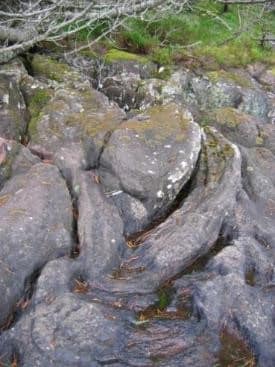
The rock COSEM L77 shows garnet lamellae 0.5 to 3 mm thick that have been exsolved (= separated) in large orthopyroxene crystals. Exsolved lamellae (= separation of constituents initially united in a homogeneous phase) are generally 10 or 100 times thinner, and visible only under a microscope. Exsolution is a common phenomenon when the temperature drops and certain atoms, which were previously stable together in a single phase, become unstable, causing them to separate and create a new, distinct phase. Here, the excess aluminium dissolved in the orthopyroxene is trapped in new grains of garnet (a mineral richer in Al) crystallised in the form of lamellae. Elsewhere in the outcrop, orthopyroxenes sometimes appear as megacrysts over 10 cm in size, which has never been described in an eclogite. This sample was collected from the centre of this fold (see photo). The rock seen here is part of a large lens of orthopyroxene eclogite covered by algae and/or lichens, as it is located by the sea. It is also evidence of significant early deformation within an eclogite lens, so that this intense folding is uncorrelated with the deformation of the host gneisses. Aarsheimneset, Stadlandet, Norway © D.C. SMITH
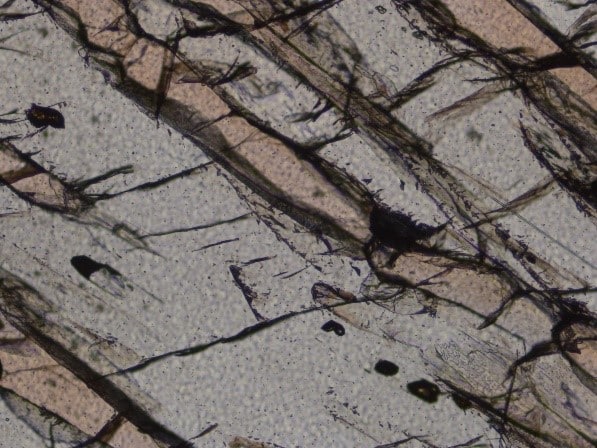
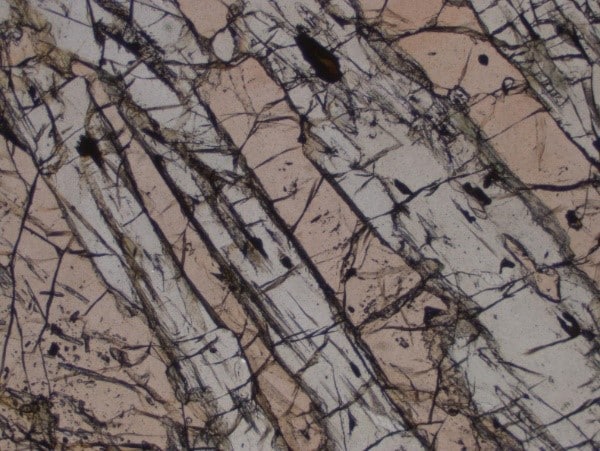
Photographs of a thin slide (sample COSEM C49 not shown here) showing garnet lamellae (pink in colour and 0.5-3 mm thick) exsolved from a transparent orthopyroxene single crystal (as in sample COSEM L77). © D.C. SMITH
COSEM LP-93i This rock comes from a lens of fresh eclogite with kyanite. However, the very small kyanites are almost invisible without a microscope. It has an attractive bedded texture with small grains of garnet and clinopyroxene.
COSEM R80 : This rock has the coronite texture of a gabbro, partly inherited from its plutonic texture. For information, this sample has not yet been studied in thin sections, so the main minerals have not yet been identified.
COSEM G184 (not on display) :
The long, narrow micas, here birefringent (magenta-coloured), are very rare sodic-magnesian mica. preiswerkite composition: Na2Mg4Al2(Al4Si4O20)(OH)4. It was discovered in Norway at Liset by David Smith in an eclogite that had undergone severe retrogradation to amphibolite. These preiswerkites are surrounded by small grains of albitic plagioclase in a matrix rich in magnetite cubes. On the left of the photo, a cryptocrystalline symplectite including corundum and plagioclase.
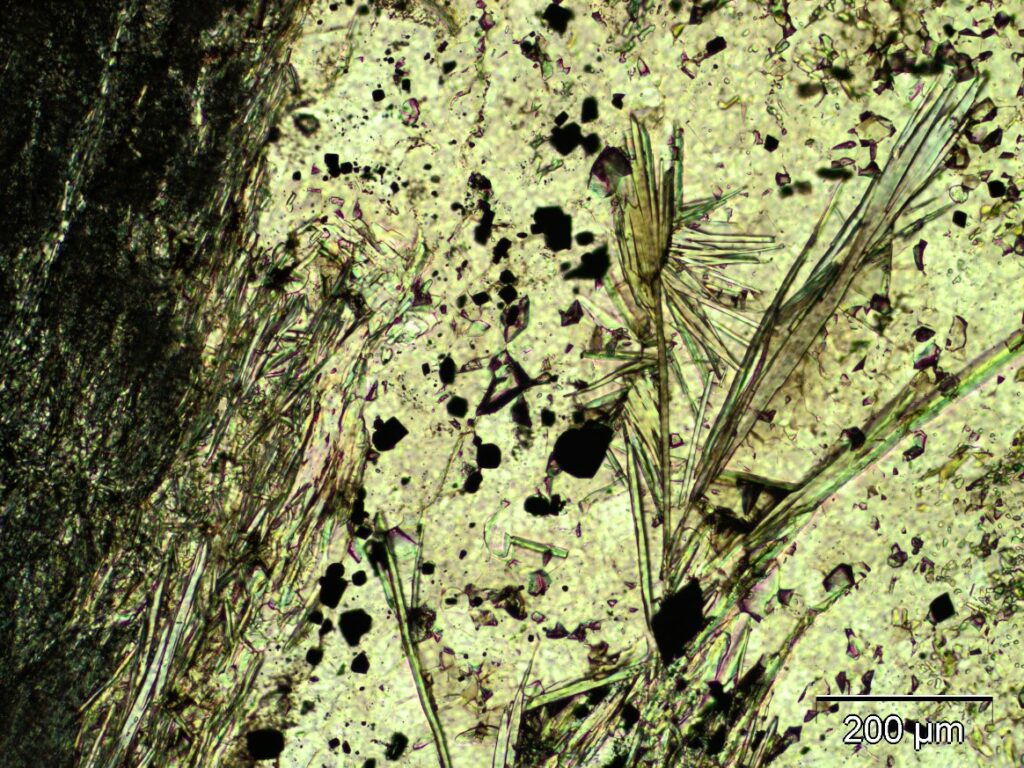

© D.C. SMITH

This photo shows narrow needles of exsolved quartz (2-20 µm thick) in a clinopyroxene from an eclogite collected at Rendeelven, Liverpool Land, in East Greenland (sample COSEM GD104406 not shown in the display case; Smith & Cheeney, 1980). Previously, this pyroxene was "supersilicic" (containing more Si than normal stoichiometry), which may indicate very high initial pressures (Smith, 1982, 2006).
Find out more:
- Smith D. C. (1988). - A review of the peculiar mineralogy of the "Norwegian coesite-eclogite province", with crystal-chemical, petrological, geochemical and geodynamical notes and an extensive bibliography, In: Smith, D. C. (Ed.), Eclogites and Eclogite-Facies Rocks, Developments in Petrology12, pp. 1-206
- Smith, D. C., Cheeney, R. F. (1980). - Orientated needles of quartz in clinopyroxene: evidence for exsolution of SiO2from a non-stoichiometric supersilicic "clinopyroxene", 26th International Geological Congress, Paris, Abstracts, p. 145
- Smith D. C (1982). – On the characterisation and credibility of supersilicic, stoichiometric and subsilicic pyroxenes, Third International Kimberlite Conference, Terra Cognita, 2(3), p. 223.
- Smith, D. C. (1986). - The SHAND quaternary system for evaluating the supersilicic or subsilicic crystal-chemistry of eclogite minerals, and potential new UHPM pyroxene and garnet end-members, Mineralogy and Petrology, 88pp. 87-122
- Oberti, R., Ungaretti, L., Tlili, A., Smith, D. C., Robert, J.-L. (1993). - The crystal structure of preiswerkite, American Mineralogist, 78, pp. 1290-1298
15. NEW OR RARE MINERAL SPECIES DISCOVERED IN THE ECLOGITES OF NORWAY

The eclogite outcropping at Nybö contains orthopyroxene and is therefore magnesian. Like many other lenses, it changes from very fresh to very retrograde eclogitic paragenesis. The upper part of this sample (COSEM G230d) is composed of garnet, often rounded, in a bedded matrix of small clinopyroxene prisms. Here the proportion of jadeite (Jd) is around 40 %, and around 60 % of {diopside + hedenbergite}, i.e. an omphacite. When we look at the lowest levels, the garnets become rarer and disappear completely, while the proportion of jadeite (Jd) in the clinopyroxene gradually increases to 73 %. This was the highest value known in Norway at the time (1980), approaching 80 % of Jd, which is the limit for the name jadeite (instead of omphacite).
There are also tiny crystals of clinoamphibole in the lower part, whose chemical composition is unknown in the literature. This is the " nyboite "A new species discovered by David Smith (and approved by the IMA: International Mineralogical Association): a clinoamphibole with a maximum possible Na content, and the IMA has approved it as a new mineral species. Its name refers to the place where it was discovered.
At the bottom, the darker part is downgraded to {plagioclase + clinoamphibole}, but this last phase has also been shown to be a new species: the " magnesio-alumino-taramite ". This name was imposed by the IMA.
© D.C. SMITH
A drawing of the crystal structure of the new mineral species nyböite discovered in the eclogite at Nybö and published in Ungaretti et al (1981). Nyböite is a very sodic and very aluminous amphibole: NaNa2Mg3Alvi2If7AlivO22(OH)2. This extreme composition did not exist in the IMA classification at the time. Like glaucophane, its Alvi in octahedral sites indicates that high pressures of blue schist or eclogite facies are necessary for its crystallisation.
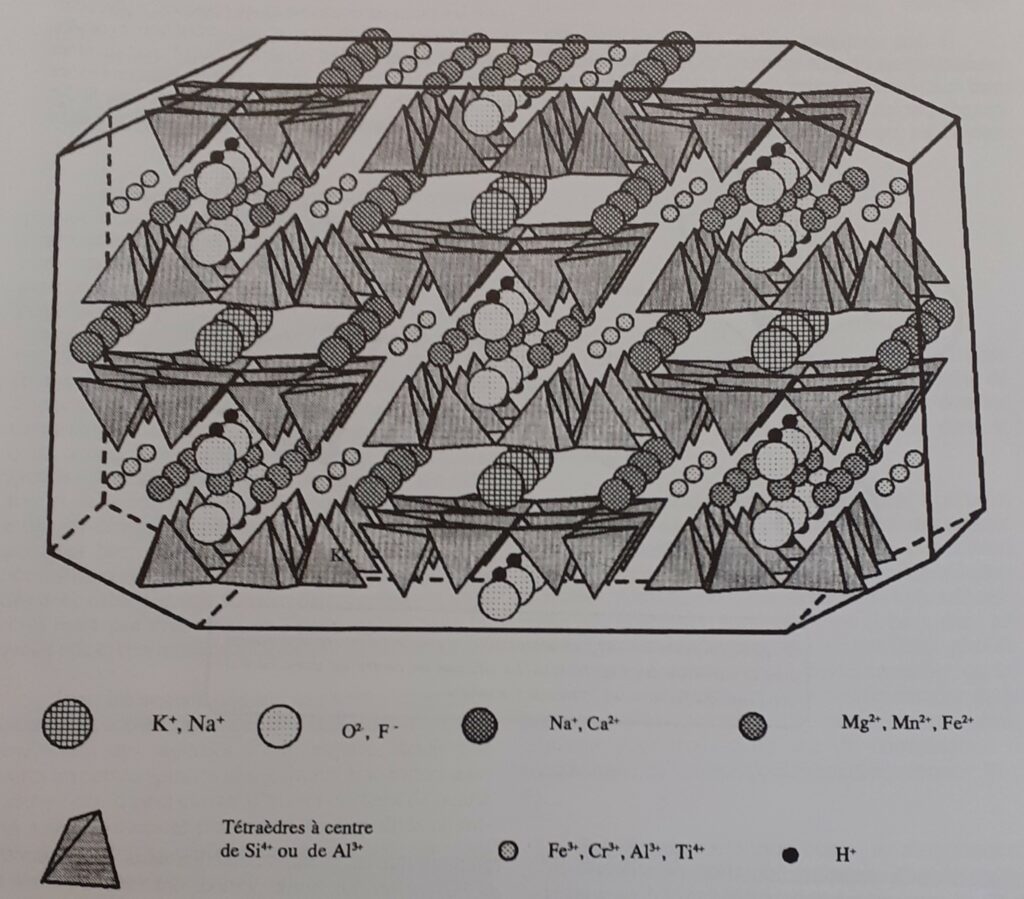
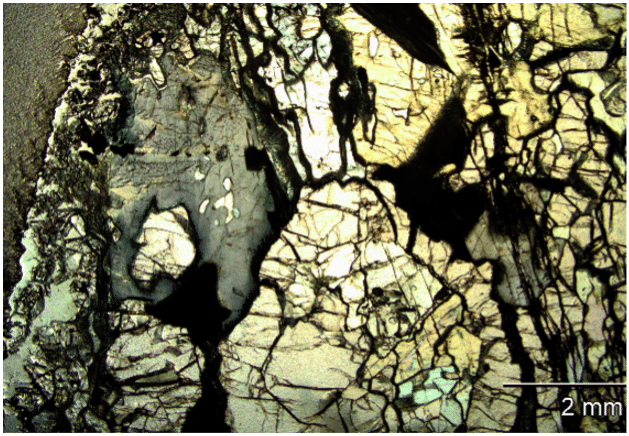
The nyböite initially discovered in the Nybö eclogites, was later discovered in the Liset eclogites in the form of larger grains. In this natural light microphotograph, Nyböite appears as large violet-grey grains (similar to glaucophane but less blue). It often contains inclusions of garnet (yellowish) or clinopyroxene (white), assembled in equilibrium in the eclogite facies. Garnets and clinopyroxenes are fresh except along fractures or blackish clusters of symplectic indicating the start of retrograde metamorphism.
© D.C. SMITH
(Magnesio-alumino-) taramite is also a clinoamphibole with a composition of NaNaCaMg3Alvi2If6Aliv2O22(OH)2 close to that of nyböite. Its high Aliv indicates that it needs less pressure than nyböite to crystallise. At Nybö, it is therefore found in very small grains in the retrograde zones, replacing the initial clinopyroxene and nyböite. At Liset, there is much more taramite, still in symplectite with plagioclase, but in larger grains and strongly green (see this photo © D.C. SMITH and the following window).

As in many other clinoamphiboles, the MgAl couple can be replaced by Fe2+Al, MgFe3+ or Fe2+Fe3+taramite, so that one of the prefixes magnesio-alumino, ferro-alumino, magnesio-ferri- or ferro-ferri- must be added to the basic name taramite, where appropriate. Ferro-ferri taramite has been known for a long time, but the world's first magnesio-alumino-taramite (Ungaretti et al., 1981) was discovered at Nybö (with nyböite), and the world's first ferro-alumino-taramite was discovered at Liset (with lisetite) (Ungaretti et al., 1985).
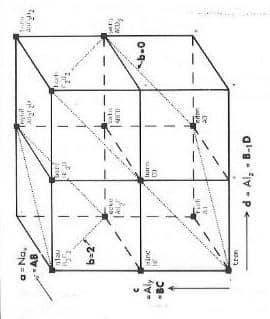
In this projection showing the compositions of clinoamphiboles, nyböite and taramite are at the top back (nybo & tara), far removed in composition from tremolite (bottom left) at the origin of this 3-dimensional crystallochemical diagram (de Smith, 1988).
COSEM C137 At first glance, this rock looks like
a typical eclogite with red garnets and green clinopyroxenes in layers
alternating. However, it is mottled with small black grains.
These are not clinoamphiboles, but tourmalines of the composition
between dravite and uvite (very rare) (Smith, 1971, 1988). This is the
the world's first tourmaline eclogite. It also contains orthopyroxene.
and clinoamphibole. The boron content of this tourmaline indicates a
initial source in the continental crust which was subducted and then
exhumed. The dravite / uvite transition (NaAl replaces CaMg, as between
diopside and jadeite) indicates high pressure.
Table of rare and new mineral species described in Norway (new species described by David Smith and his team in green):
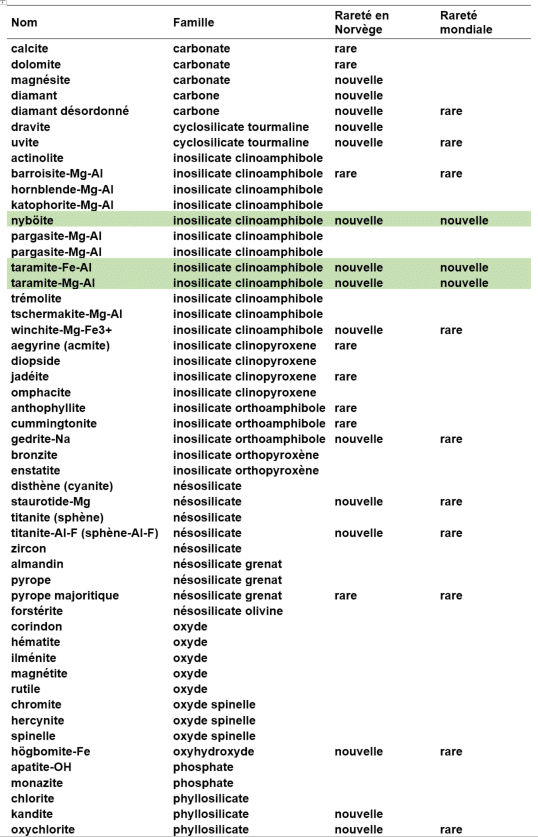

To find out more:
- Ungaretti, L., Smith, D., Rossi, G. (1981). - Crystal-chemistry by X-ray structure refinement and electron microprobe analysis of a series of sodic-calcic to alkali-amphiboles from the Nybö eclogite pod, Norway. Bulletin de Minéralogie104(4), pp. 400-412.
- Smith, D. C. (1971). - A tourmaline-eclogite from Sunnmöre, Norsk Geologisk Tidsskrift51, pp. 141-147.
- Ungaretti, L., Oberti, R., Smith, D. C. (1985). - X-ray crystal structure refinements of ferro-alumino- and magnesio-alumino-taramites from the Liset eclogite pod, Norway, Terra Cognita, 5(4), pp. 429-430.
- Smith D. C. (1988). - A review of the peculiar mineralogy of the "Norwegian coesite-eclogite province", with crystal-chemical, petrological, geochemical and geodynamical notes and an extensive bibliography, In: Smith, D. C. (Ed.), Eclogites and Eclogite-Facies Rocks, Developments in Petrology12, pp. 1-206
- Oberti, R., Ungaretti, L., Tlili, A., Smith, D. C., Robert, J.-L. (1993). - The crystal structure of preiswerkite, American Mineralogist, 78, pp. 1290-1298
16 COSEM and the "David Smithite" movement
The best eclogite outcrops in Norway are by the sea. The west coast of Norway is famous for its countless fjords and coves and its almost constant rain. Before the recent construction of many bridges and tunnels, it was necessary to use ferries. And sometimes the sun was visible!
David Smith on a Norwegian ferry. © D.C. SMITH
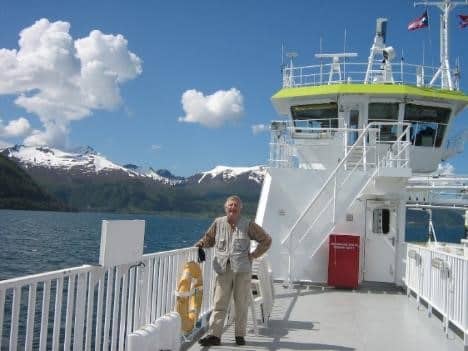

When David C. Smith collected samples of eclogites embedded in gneisses during his Masters course in Norway in 1967, he had no idea that he would become fascinated by these mysterious and beautiful rocks. His research propelled him to become Professor at the Muséum National d'Histoire Naturelle in Paris in 1980, at the invitation of Jacques Fabriès, who held the Chair of Mineralogy at the MNHN. Having become Professor Emeritus on his official retirement in 2012, David Smith decided to transform his private research collection, comprising three tonnes of eclogites collected from all over the world, by donation into a State Collection called COSEM ("Smith Collection of World Eclogites"). More than 2,000 samples were selected for inclusion in the Museum's collections, including those presented in this exhibition, which illustrate the mineralogical diversity of Norwegian eclogites.
David Smith's initial idea was:
- to bring together in one place, and especially at the MNHN, the cradle of the study of eclogites since Haüy (1822) and Brière (1920), the greatest possible variety of representative samples of the "eclogites of the world" as a new state collection;
- to enrich it with new acquisitions and donations;
- to select samples for teaching purposes and possible exhibitions aimed at the general public, in order to raise awareness and provide an introduction to the complicated but impressive phenomenon of high and ultra-high pressure metamorphism (UHPM), by presenting some very fine samples in a series of "teaching kits" organised by theme;
- to make it accessible to researchers around the world and, above all, for posterity.
Sample sources
Most of the samples were collected by David himself; they were organised into distinct "sub-collections according to country of origin, year of harvest, or other criteria. Some colleagues kindly offered him some samples they had collected themselves, and these have become additional sub-collections. David would also like to thank his 29 colleagues from different countries who donated samples to COSEM (289 in total) in order to increase the worldwide representativeness of this unique collection (see the list of collectors). All this information is compiled in a database in which the 2241 samples can be sorted in several ways. This database and all the samples have been donated to the Museum's Collections Department so that COSEM can become a State Collection and serve the scientific community as a reference on eclogites for centuries to come.
Extensive research, data acquisition and publications
The range of studies of the samples collected in COSEM is extremely varied. Many have been processed into thin sections. The most interesting rocks underwent more detailed analysis: chemical analysis of the overall rock by conventional wet chemistry or by X-ray fluorescence (XRF); mineral and/or crystallographic analysis by X-ray diffraction (XRD), analysis by electron microprobe (EMP), scanning electron microscope (SEM) or transmission electron microscope (TEM), Raman microscopy (MSR) and structure refinement (SREF); this last method was used in particular for the new mineral species discovered by David and/or his teammates.
The results of these studies were presented in David's two theses (SMITH 1968, 1976) and in numerous international scientific publications, book chapters, scientific journals and newspapers. There is also an abundance of "published abstracts", such as in TERRA COGNITA on the first conference in the series "International Eclogite Conferences" (IEC), of which David was one of the co-founders. This journal went on to establish the new journal TERRA ABSTRACTS, of which David was a founding editor. A full list of all these various publications is provided here in the Work list.
Unfortunately, many other research results acquired by David on the COSEM rocks have not been, and never will be, published, for lack of time and/or money. Also, many COSEM samples have never been analysed. Despite this, samples without analytical data have been kept within COSEM in order to provide a good collection of all the rock types that exist at the sampled locations. Rocks that, for one reason or another, were of less scientific interest have already been eliminated from COSEM.
New mineral species found
This collection contains a huge amount of mineral material to be exploited. Several new mineral species (e.g. nyböite, Mg- or Fe-aluminotaramite, lisetite), or others that are very rare in the mineral world, have already been discovered in COSEM rocks (see the list of new or rare species found in norwegian eclogites). These important discoveries, which have thus enriched the international catalogues of species recognised by the IMA (International Mineralogical Association), were acquired thanks to the exceptional chemical and geodynamic conditions (e.g. UHPM) of the Norwegian eclogite formation, but also to David's particular interest in crystallochemistry. There's nothing to say that there aren't other new mineral species to be discovered in this collection, just waiting to be found!
Types of rock collected
The COSEM includes different types of rock (jointly decided with the head of the MNHN Petrology Collections):
1 – High-pressure or ultra-high-pressure rocks with "eclogite" or "blue schist" metamorphic facies. These two facies correspond to pressures and temperatures where the plagioclase mineral is no longer stable; the main minerals are a sodium clinopyroxene rich in the jadeite pole and a magnesian garnet rich in the pyrope pole. These two species are often accompanied by quartz, cyanite or zoïsite. Orthopyroxene, a clinoamphibole such as glaucophane or nyböite and a mica such as paragonite, phengite or phlogopite may also coexist. Sometimes there are UHPM-indicating minerals such as coesite or diamond.
2 – Prograding or retrograde metamorphic rocksIn other words, formed before or after the peak of metamorphism during burial by subduction or during exhumation in a collision or Metamorphic Core Complex context, for example.
3 – The surrounding rocks. It is often the rocks known as 'gneiss' or 'schist' that, in the field, are generally found associated with eclogite 'lenses'. The origin and evolution of these non-eclogitic rocks are intimately linked with those of the eclogites, so it is essential to study them at the same time.
4 – Deep rocks often associated with eclogites in metamorphic terrains, such as anorthosites, granulites, metadolerites, metagabbros, dunites, peridotites, lherzolites, etc.
5 – Nodules of high-pressure or ultra-high-pressure rock in the Earth's mantle which are found in volcanic rocks or kimberlite diatremes (vertical channels from which mantle material has been rapidly brought to the surface). These 'host' rocks have upwelled fragments of heavier rock, including eclogites.
6- Special associated rocks which do not fall into the above classification but which outcrop in the vicinity of eclogites, blue schists or others and which may have played a role in the genesis of these high-pressure rocks. Here we include materials transformed or incorporated by injection or partial fusion: veins or pegmatites; or by compression: mylonites or pseudotachylites.
COSEM includes a majority of Norwegian rocks, as David Smith has focused his research on Norwegian eclogites. These rocks have proved to be very important scientifically because of the ultra-high pressures found there, the many new mineral species discovered there, and the very good exposure of the outcrops (little vegetation and good preservation).
The sample COSEM G201 shows reddish parts containing partially retromorphosed garnets and other greener, grey or white parts that are strongly retromorphosed and poor in eclogitic facies garnets. In these lighter parts, clinopyroxene crystals remain containing around 80 % of jadeite (Jd) but also quartz, demonstrating the destabilisation of the {jadeite + quartz} couple (previously unknown in Norway); this couple is an indication of high pressure > 20 kbar at 750°C. The red rectangles show the locations of several thin sections made to study this unusual rock. A previously unknown mineralogical phase was discovered by David Smith, who named it " lisetite ". It is a feldspathoid formed, most probably, by the retrogression of paragonite (high-pressure sodium mica). This is the first time that a feldspathoid has been described in a Norwegian eclogite lens.
Another new phase was discovered and named davidsmithite "Kechid et al (2017). Also recognised by the IMA, it is also a feldspathoid, more sodic than lisetite. This other new species crystallised during retrogression because it often inter-grows with lisetite. Along with nepheline and trinepheline, davidsmithite belongs to the nepheline structural group, as can be seen in the triangular crystallochemical diagram below.
The Liset lens is clearly unique, as is the Nybö lens; these two eclogite lenses are the most sodic known in Norway. Smith (1988) describes the WGR eclogite zone as "a mineralogist's paradise but a petrologist's nightmare".

In this photo of the eclogite lens at Liset, you can see dark grey and light grey layers that are very amphibolitic eclogite, hence the type sample of lisetite and davidsmithite (G201) were extracted. At bottom left the eclogite is only slightly retrograded and the colours of the fresh large grains of red garnet and green clinopyroxene are clearly visible. At the top right, the same rock is covered with dark yellow or pale lichens. Behind this remarkable outcrop is the famous Stadlandet peninsula. © D.C. SMITH
This image of an unanalysed polarised light (UPL) thin section of the COSEM G209g rock (not on display) from the Liset eclogite shows that the lisetite and davidsmithite coexist in light or dark grey areas (=retromorphosed eclogite). These include: 1. a long oblique lath (bottom right) and 2. a wide irregular zone (top left). These textures, which could represent old rods of an initial mica cut in two perpendicular directions, are symplectites. They have a transparent matrix composed of intercrossings of lisetite and davidsmithite. This matrix is rich in micro-inclusions of Mg-Fe-Ti oxides, and is always surrounded by a crown of green Al-taramite. In polarised light analysis (XPL), the two feldspathoid species can often be distinguished by their birefringence, which is lower for davidsmithite because it belongs to the nepheline group. The outer symplectites are mainly plagioclase with small grains of Al-taramite in place of the original clinopyroxene. The blackish clusters are other magnetite-rich symplectites replacing garnet © D.C. SMITH

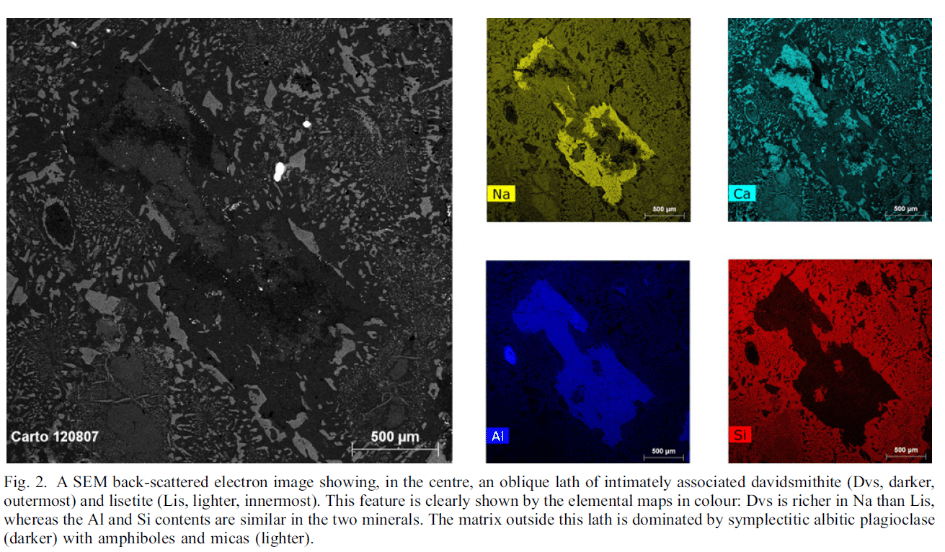
This image from Kechid et al (2017) acquired by a scanning electron microscope (SEM) shows an almost rectangular lath 3 mm long, where the more calcic lisetite is located rather towards the centre (see Ca mapping top right in sky blue), while the more sodic davidsmithite is located rather towards the edges (see Na mapping top left in yellow).
The table in Smith (2023) shows the actual and schematic chemical compositions of eight mineral species with the composition R+AlSiO4 shown here with 16 oxygen atoms, all of which would have the crystal structure of nepheline, where R+ includes K+Na+ or [Ca0.5□0.5] + and □ = a vacant site. By definition, all these species recognised by the IMA have different chemical compositions and crystal structures.
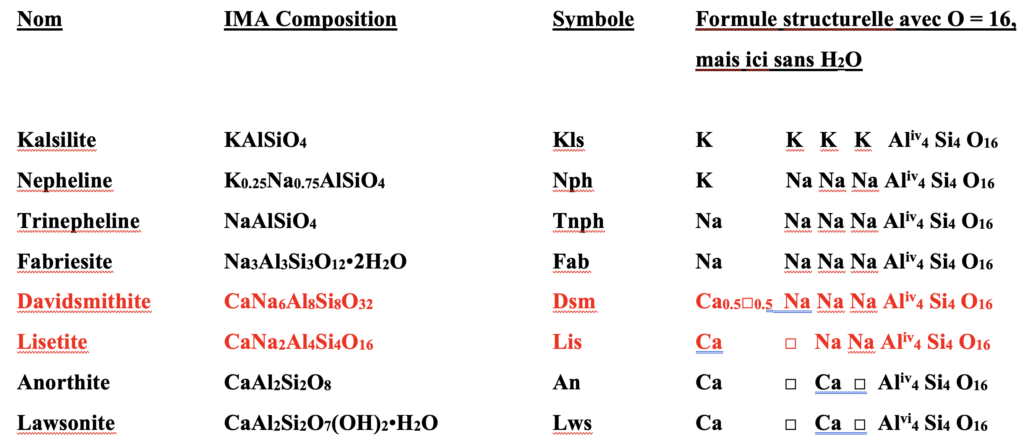
Note that lisetite is close in composition to anorthite feldspar, but has two Na+ atom instead of a Ca2+. Davidsmithite is close in composition to lisetite, but every second Ca atom is absent, and its positive charge is replaced by two Na atoms (2Ca2+ = Ca2+ + 2Na+) or (Ca2+ = Ca2+0.5 □0.5 + Na+).
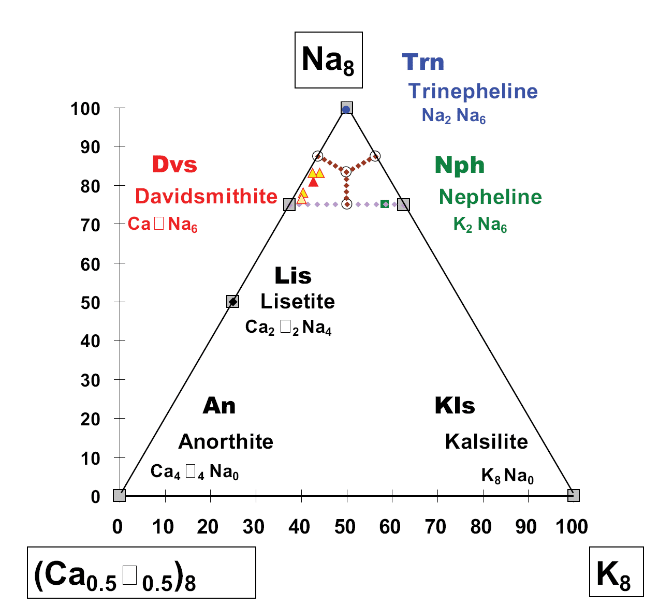
We We can see from the triangular diagram, which plots the ratios of ideal mineral compositions in K, Na & Ca atoms, that lisetite falls halfway between anorthite and trinepheline, and the pure pole of davidsmithite falls halfway between lisetite and trinepheline. Actual mineral compositions may vary. According to Kechid et al (2017).
The book is displayed in a window:
- Kechid, S. A., Parodi, G. C., Pont, S., & Oberti, R. (2017). Davidsmithite, (Ca,□) 2Na6Al8Si8O32: a new, Ca-bearing nepheline-group mineral from the Western Gneiss Region, Norway. European Journal of Mineralogy29(6), pp. 1005-1013.
To find out more:
- Rossi, G., Oberti, R., Smith, D .C. (1986). - The crystal structure of lisetite, American Mineralogist71, pp. 1378-1383.
- Smith, D. C., Kechid, S.-A., Rossi, R. (1986). - Occurrence and properties of lisetite, CaNa2Al4Si4O16, a new tektosilicate in the Ca-Na-Al-Si-O system, American Mineralogist71, pp. 1372-1377.
17 Implications for geodynamics
One of the great enigmas of terrestrial geodynamics is to know when plate tectonics, as we know it today, began on Earth and what geodynamic processes dominated on the ancient Earth. Repondering these major questions is an essential challenge if we are to understand, on a larger scale, the transition from an ancient Earth to a modern Earth, and the global phenomena that took place there: the formation of the mantle and crust, the appearance of water, the event of great oxygenation of the atmosphere, which had major implications for the increase in the number of mineral species and for the evolution of Life on our planet.
Although numerous studies have tried to determine when plate tectonics appeared on Earth and whether this phenomenon was progressive or a one-off event, no consensus has been reached to date.
Ultra-high-pressure, low-temperature ((U)HP-BT) metamorphic rocks such as eclogites provide crucial clues to geodynamic processes, as these rocks are currently only produced in subduction environments and are therefore evidence of modern plate tectonics. In fact, the PTt (or t = time) conditions recorded by eclogites (low temperature and high pressure) and certain index minerals they contain (e.g. omphacite, coesite, glaucophane, lawsonite, carpholite) are indisputable indicators of the presence of deep subduction involving the burial of relatively cold oceanic crust in the mantle at great depth (> 70 km) and therefore at high pressure. These types of rock were not produced during the Archean, when maximum recorded pressures did not exceed 15 kbar and the T gradient was much stronger.
There are three key periods in this transition:
The Archaean and ancient geodynamics This very long period records major geological events. Despite the presence of metamorphic rocks (< 15 kbar), no consensus has been reached as to the geodynamic processes present (sagduction, flat subduction).
The Paleoproterozoic and the 1st evidence of proto-subduction This pivotal period records the oldest eclogite occurrences (1.8 - 2.2 Ga) in the world. These rocks are the oldest evidence of proto-subduction (with pressures of between 15 and 25 kbar ± low temperatures) across the globe.
From the Neoproterozoic to the present day, with the emergence and maintenance of deep subduction This period saw the first occurrences of UHP metamorphic rocks containing coesite (> 25 kbar), evidence of subduction with deep burial in the mantle.
BAR-11-12 This sample from the Barberton region of South Africa
South Africa, shows amphiboles, garnets, titanites, feldspars and rare pyroxenes.
rare pyroxenes. Some authors (Moyen et al., 2006) suggest that this garnet-bearing
garnet amphibolite, dated at 3.2 Ga
(François, 2014), is thought to be a witness to Archean subduction:

© C. François
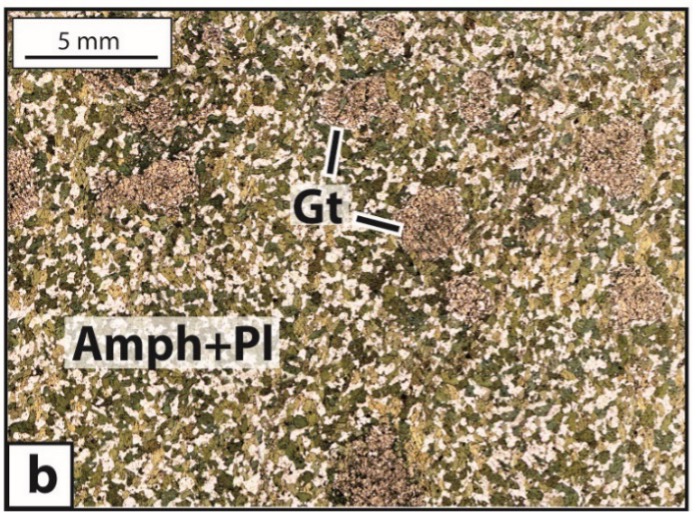
RG-45977 This rock (historical sample from the Africa Museum, Belgium) is a retromorphosed eclogite from the Kasai region (Democratic Republic of Congo). It contains garnet, amphibole, pyroxene, rutile, plagioclase feldspar and quartz. Dated at 2.1 Ga with pressure-temperature conditions of 17-13 kbar & 500-550°C, this rock was formed during theEburnian orogeny. It is therefore the oldest high-pressure eclogite in the world and proves that plate tectonics was functional on Earth as early as the Palaeoproterozoic (François et al., 2018):

COSEM B361 This magnesian eclogite comes from Nybö (Sörpollen) in Norway and was formed during theThe Caledonian orogeny about 420 Ma. This eclogite is mainly composed of prismatic clinopyroxenes and contains layers rich in garnet and layers rich in bedded phlogopite (sheets subparallel to the bedding of the clinopyroxenes). It is one of the oldest pieces of eclogite evidence in UHP, and therefore bears witness to the presence of a 'modern' subduction as early as the Silurian.
CF2 This sample of eclogite from Compointerie in Saint-Philbert-de-Grand-Lieu in the Vendée contains mainly garnet and pyroxene (omphacite). It was formed during theHercynian orogeny about 355 Ma.
CF3 This sample of blue schist with lawsonite and eclogite veins comes from Mont San Petrone in alpine Corsica. The rock was formed during the Alpine orogeny around 35 Ma. The blue schist part contains glaucophane, actinolite, lawsonite, garnet, phengite and titanite. The eclogite vein is composed of omphacite, lawsonite, garnet, phengite and titanite. Lawsonite eclogite is very rare, with fewer than 10 localities worldwide (Brovarone et al., 2011).
98BThis fresh eclogite pebble comes from West Papua (Lent by Julia de Sigoyer). It is composed of garnet (sometimes in atolls), clinopyroxene, quartz, amphibole and rutile. The associated metasediments contain garnets up to 10 cm in diameter. Dated between 5.5 and 8 Ma with P-T conditions of 17-23 kbar and 700-800°C, this eclogite is one of the youngest in the world (François et al., 2016). This sample also shows that burial and exhumation can be very rapid in certain subduction zones.

Geodynamic evolution on Earth: Archean, Palaeoproterozoic and Neoproterozoic (= modern Earth) and corresponding Pressure-Temperature diagram. © C. François
To find out more:
- Moyen, J. F., Stevens, G., & Kisters, A. (2006). - Record of mid-Archaean subduction from metamorphism in the Barberton terrain, South Africa, Nature442(7102), pp. 559-562.
- Brovarone, A. V., Groppo, C., Hetényi, G., Compagnoni, R., Malavieille, J. (2011). -Coexistence of lawsonite-bearing eclogite and blueschist: phase equilibria modelling of Alpine Corsica metabasalts and petrological evolution of subducting slabs,Journal of Metamorphic Geology29(5), pp. 583-600.
- François, C., de Sigoyer, J., Pubellier, M., Bailly, V., Cocherie, A., & Ringenbach, J. C. (2016). - Short-lived subduction and exhumation in Western Papua (Wandamen peninsula): co-existence of HP and HT metamorphic rocks in a young geodynamic setting, Lithos266, pp. 44-63.
- François, C., Debaille, V., Paquette, J. L., Baudet, D., & Javaux, E. J. (2018). - The earliest evidence for modern-style plate tectonics recorded by HP-LT metamorphism in the Paleoproterozoic of the Democratic Republic of the Congo, Scientific reports8(1), nr. 15452.
Available from the SGF shop:
- Collective (2014). - Alpine Corsica, Géochronique, 132, 60 p.
https://www.geosoc.fr/boutique-en-ligne/geochronique/la-corse-alpine-detail.html

Exhibition co-organised by the Geological Society of Francethe Commission for the Geological Map of Francethe National Museum of Natural History and the IGCP-667 (UNESCO – IUGS): World map of orogens
Acknowledgments
David Smith collected these eclogite samples during his long stays in Norway, either alone or with a group of geologists (for example during an excursion organised by an international congress), or assisted in the field at different times by : Haavard Buset, Harald Buset, Alan Deeney, Chiara Domeneghetti, Mary H. Inglis, Roberta Oberti & Edward B. Walsworth-Bell) to whom David expresses his immense gratitude. David would also like to thank Sid-Ali Kechid, his former student, who wrote his doctoral thesis on the extraordinary Liset eclogite lens.
David would particularly like to thank the various curators of the MNHN mineralogical collections: Gabriel Carlier, Cristiano Ferraris and in particular Violaine Sautter for their ongoing support over many years.
David is grateful to Management from the Société Géologique de France for the opportunity to present COSEM at this exhibition. It's an ideal way of showcasing this unique collection to other eclogite specialists, geology professionals and enthusiasts, not to mention the general public and young people who may never have heard of the term 'eclogite'. This exhibition would probably not have been possible without the support of Solen Le Gardienthe head of SGF's library, who has selected and revived old works from SGF's library collection relating to the world of eclogites, and without the scientific support of Camille François, of the Commission for the Geological Map of the World, for improving the texts and presenting his remarkable subduction diagrams to help the reader understand difficult geodynamic concepts.
Finally, this important result, the very existence of COSEM and its presentation at this exhibition, could not have been achieved without the precise and invaluable help and ongoing dedication of Mary H. Inglis to whom David is immensely grateful. For over ten years, Mary has given up much of her time to help David with his three tonnes of rocks. In the course of this entirely voluntary work, Mary has painted, renumbered, packaged and indexed the location of over 2,000 samples!
SGF and CCGM would like to thank Guillaume Bonnet, Julia de Sigoyer, Denis Blanc and the Africa Museum for their loan of samples, as well as all those who contributed to the production of this exhibition.
Design of the web page: Andrei Rosu
